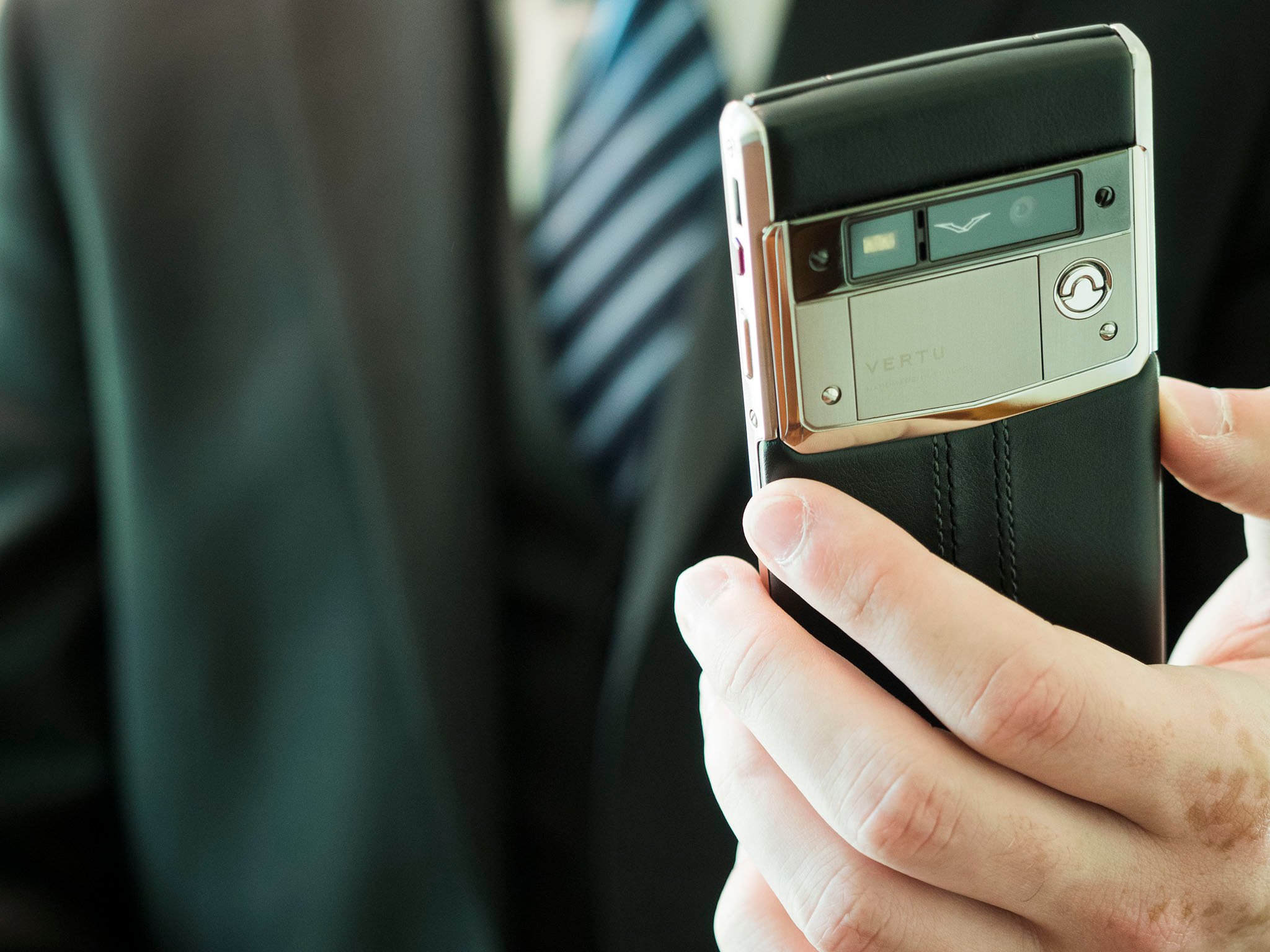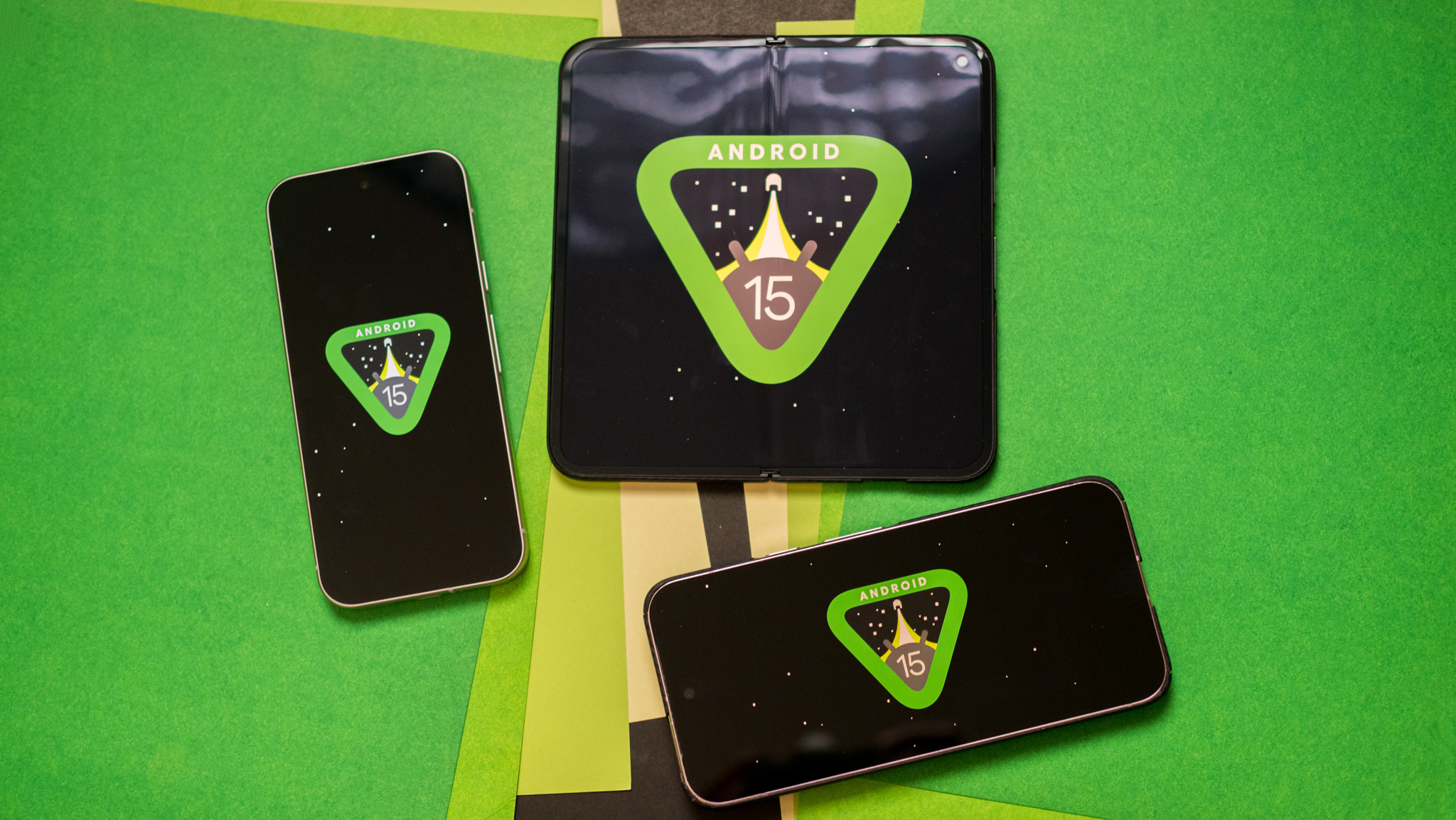The quick take
Made of premium materials with a solid design, the Vertu Signature Touch is an impressive piece of hardware with some cool services to back it up. But it's hobbled by inconsistent performance that hurts the value proposition.
The Good
- Sapphire screen, titanium and leather body
- One-touch concierge access
- Nearly stock Android
The Bad
- Frequent lagging glitches
- Still a normal smartphone inside
- Poor camera performance
- 4.7-inch HD display
- 1920x1080 resolution (473ppi)
- Sapphire crystal cover
- 16MP, Hasselblad certified
- 2.1MP front-facing camera
- 2275 mAh battery
- 15 hours talk time, 380 hours standby
- Qi wireless charging
- Qualcomm Snapdragon 801 processor
- Quad-core 2.3GHz
- 2GB RAM
- 64GB internal storage
- 24/7 concierge: phone, email, or chat
- Vertu Life curated privileges and services
Just what does $9,000 get you in a smartphone?
Vertu Signature Touch Full Review
"Hey, what phone is that?" Normally conversations I have with friends about phones come down to why I carry two at any one point or why those two are constantly changing. But it's rare that a just any phone sitting on a table prompts conversation like that. But the Vertu Signature Touch isn't just any phone.
Truth be told, this wasn't the first time I'd had this very conversation. I'd only had the phone for a few days and had gone through the process of explaining it a few times over. So I did it again, starting by casually handing them the phone.
"This is the Vertu Signature Touch."
"Ver-who?"
"Vertu."
He turned the phone over in his hands, "This is really nice. How much is it?"
"Well …" I pointed at the display, "The screen is covered with sapphire crystal. The body is made out of titanium," I turned the phone over in his hand, "And real calf leather." I took the phone back, hooked my thumbnail into the D-ring on the back, "It was handmade in England." A twist of the D-ring popped open the metal SIM card door, and I pointed at the inside of the door, "And that's the signature of the guy who put it together."
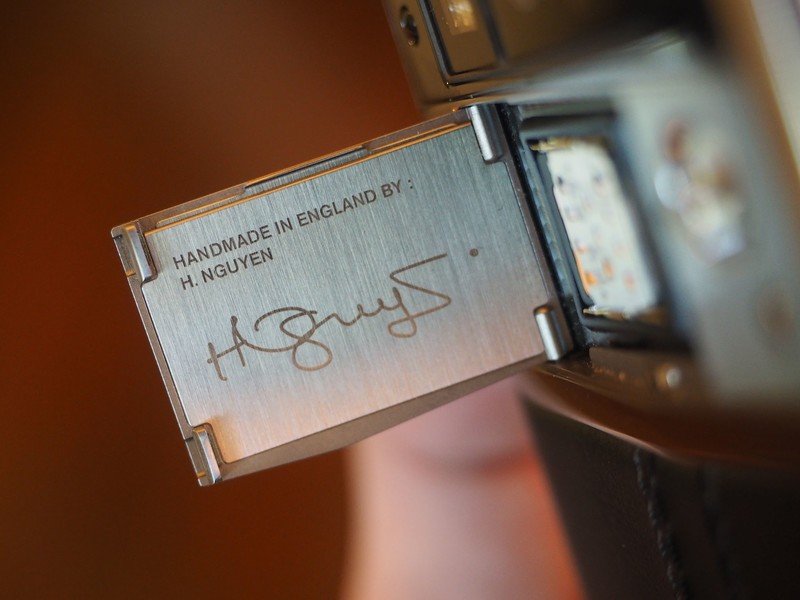
"Whaaaaat?" He leaned in close to inspect the engraved mark.
I snapped the SIM door closed, turned to the right side of the phone, and tapped my finger right next to the transparent red button by the power button "And this button is a ruby; it opens a 24/7 concierge."
He looked down at the phone, up at me, back at the phone, and then back up at me, "Seriously?"
I handed the phone back to him, "Seriously. Now how much is it?"
He flipped the phone over in his hands, running his fingers over the stitching in the leather back, "A thousand dollars."
"Okay, for comparison: your iPhone is really a $650 phone."
"Hmmm … two-thousand."
"Higher." I let a bit of a smirk show on my face.
"Five-thousand?" I shook my head back and forth, prompting a "Good lord, how much is it?"
I smiled, "Nine-thousand dollars."
He shouted, "What?" A few people around us turned to see what the commotion was about, finding a guy holding a phone. He gingerly set it on the table, "Nine-thousand dollars? How the … wha t…" He picked it back up and said softly, "That's a really nice phone."
"Yeah, it is."
About this review
We're writing this review after about two weeks using the Vertu Signature Touch. Ours was the jet black calf leather model. During this time we had the phone connected to a Moto 360 smartwatch over Bluetooth.
The Vertu Signature Touch was released in summer 2014, but with the solid gold Apple Watch Edition making waves in luxury technology, we thought it was time to take a look at what Vertu has to offer for users of a certain tax bracket.
Titanium, sapphire, leather …
Vertu Signature Touch Hardware
Your standard flagship phone in 2014 is made out of one of a few materials: chemically-strengthened glass, plastic/polycarbonate, and/or aluminum. There are a few outliers, like the wood backs available on the Moto X or the leather on it or the LG G4. But no phone you can buy from your local carrier store is made of materials as nice as the Vertu Signature Touch.
We'll start with the display, which is a 4.7-inch 1080p LCD. It's not a large display, but it's flanked by substantial bezels on all sides. The screen itself offers true colors and a bright enough backlight, but it was easily overpowered by direct sunlight. Overtop of that LCD panel is a sheet of sapphire crystal, inset slightly on all sides. Sapphire is used here for the same reason it's used in luxury watches: it offers better optical clarity and stronger damage resistance than glass, even of the Gorilla variety. Sapphire is remarkably difficult to scratch, sitting at 9 on the Mohs hardness scale (with moissanite (9.25) and diamond (10) as the only minerals that rank as harder).
MORE: The science behind smartphone glass, in our Smartphone Futurology series
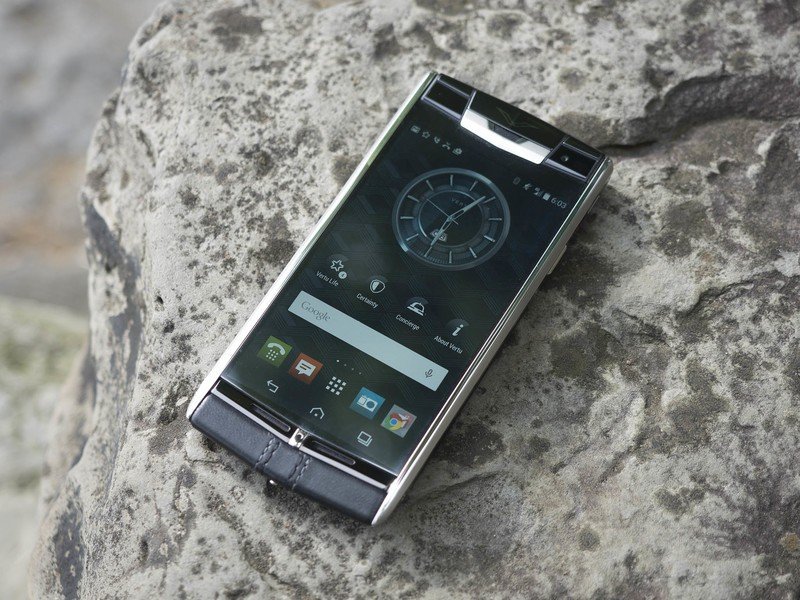
Sapphire is also notoriously hard to manufacture in mass quantities. Apple reportedly intended to use sapphire as the covering material for the iPhone 6, and spent hundreds of millions of dollars trying to get the factory to make sapphire covers up and running in time. In the end, the company they were contracting with couldn't deliver at the scale and price Apple needed and went bankrupt.
Vertu has been using sapphire crystal to cover the displays on its phones for years
Vertu, meanwhile, has been using sapphire crystal to cover the displays on its phones for years — though they have the advantage of being able to charge much more than Apple does while working at a significantly smaller scale.
Above the display on the Signature Touch is the phone earpiece, surrounded by a brushed metal overlay on the bottom and black ceramic plates on the top and sides (Vertu calls this the "pillow"). The arrangement is ever so slightly pointed down; the downward-pointing triangle has long been a signature design element of Vertu phones, though they've seriously toned down the aggressiveness of the point in recent years. To the right of the speaker is the front-facing 2.1MP camera, while the left side houses a multi-color notification light.
Below the screen is another design flourish in the front-facing stereo speakers. There's a small metal block in the center with a hole for the microphone, flanked on either side by pitched metallic covers for the speakers. Dolby is responsible for the tuning of these speakers, and they pump out quite loud audio for the size of the phone, though it can distort noticeably if things get too loud.
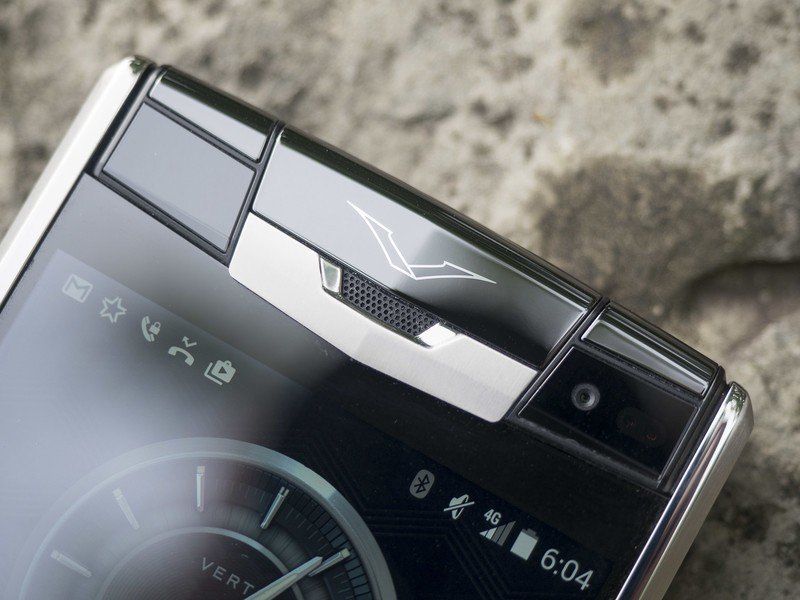
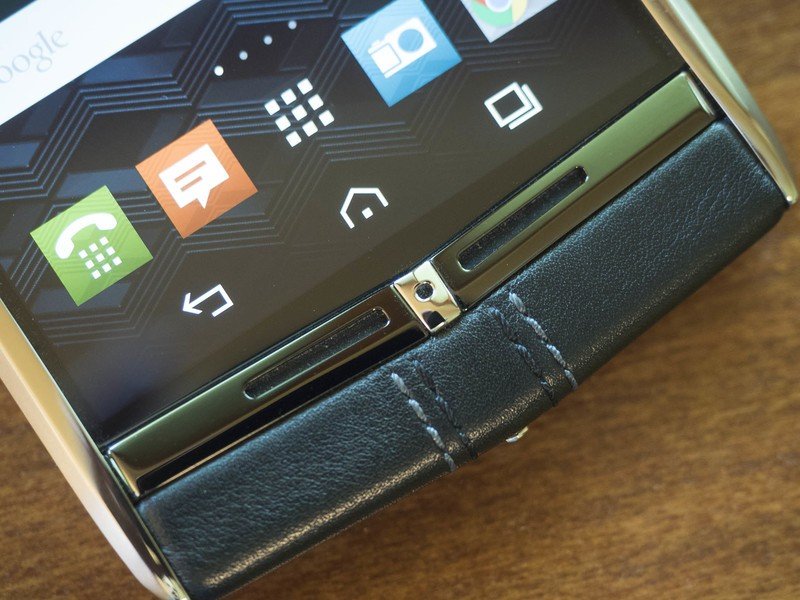
On either side of the Signature Touch run Grade 5 titanium rails, polished on the front, sides, and back with a light brushed finish on the large bezels. The left side houses the headphone jack, which sits at the top and sticks straight out the side. It's a frustrating positioning, making it awkward to slide the phone into your pocket while using headphones, though the included Bang & Olufsen-tuned earbuds have a 90-degree plug. Below the headphone jack is a pair of silver volume buttons. On both sides you'll also find three exposed screws, lending a bit of an industrial look to the phone.
The right side includes the Micro USB port (like the headphone jack, it sticks out to the side), a power button, and a small, red, trapezoidal button: that'd be the ruby button that's dedicated to launching the Concierge app. Each of the three silver buttons offers a decent click, though there's a disappointing amount of wiggle with each for the overall construction of the phone. The ruby button, however, is firmly placed and actuates with an audible click. Far too often, though, I found that I had pressed either the power or ruby buttons in my pocket and managed to unlock the phone.
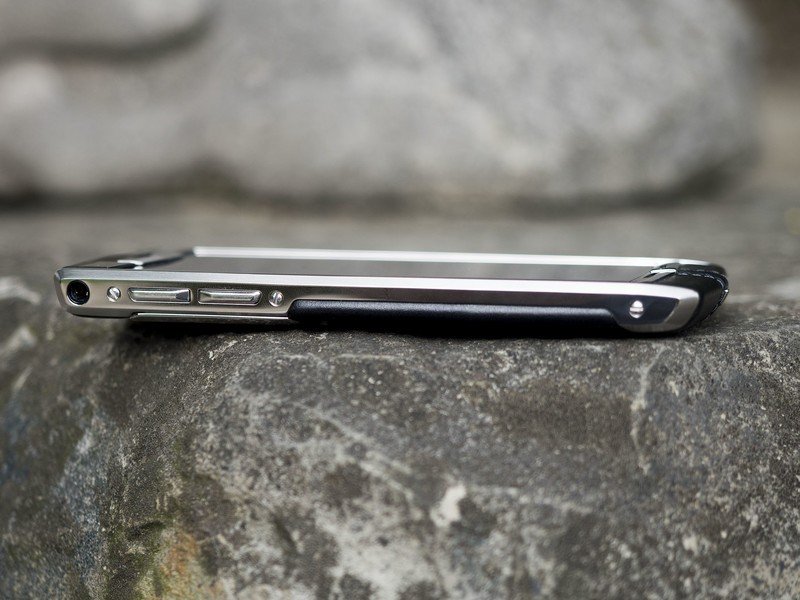
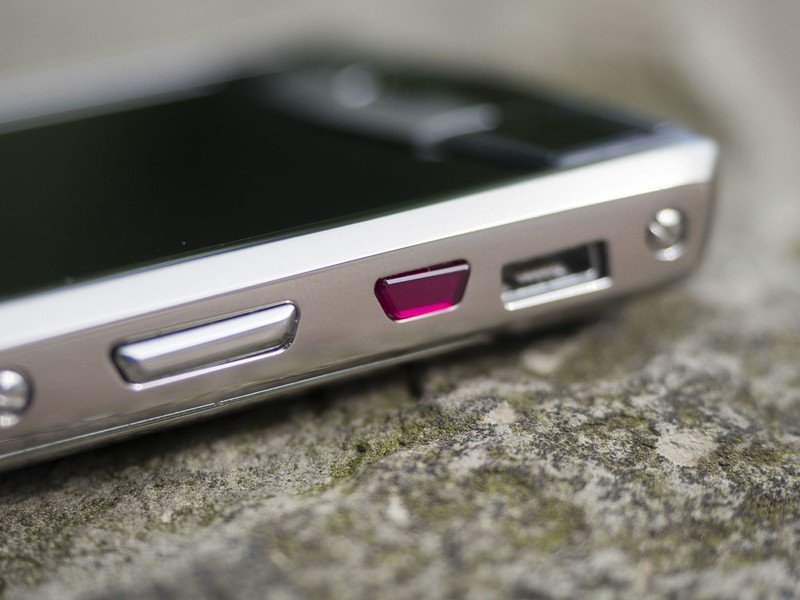
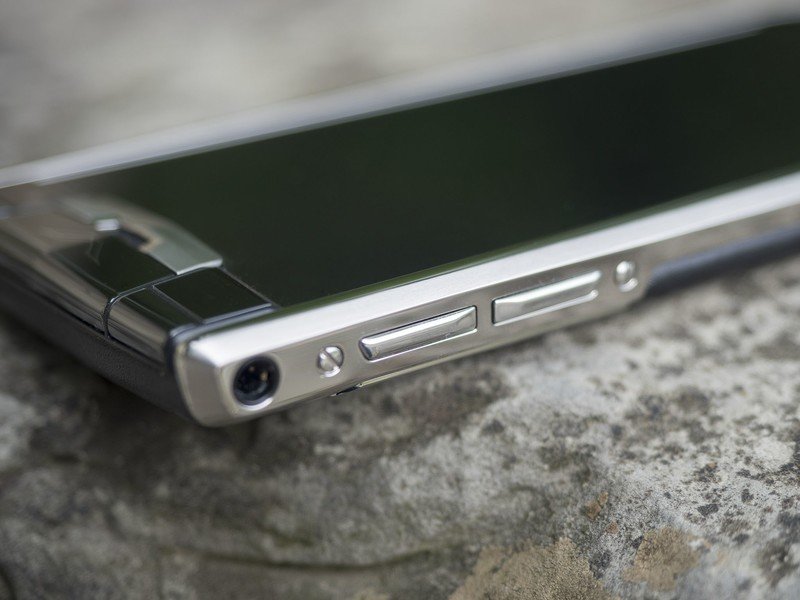
Turn the phone over and it's as much of a visual feast as on the front. The lower half of the phone is dominated by soft black leather with a quartet of stitch lines running down the middle. The titanium frame cuts back on the sides, letting the leather wrap over a bit, while on the lower corners the metal cuts in, offering a hard response to any damaging blows (we've seen the leather corners on the LG G4 suffer from visible damage after just a few weeks).
The leather is the nicest we've seen on any smartphone, easily outclassing the thin, industrial leather on the Moto X and LG G4.
The leather wraps around the bottom of the phone and forms a chin on the front, with a second little metal accent at the point on the very bottom. The leather here is the nicest we've seen on any smartphone, easily outclassing the thin, industrial leather on the Moto X and LG G4. There's another swath of leather at the top of the back, wrapping around to meet the ceramic plate from the front.
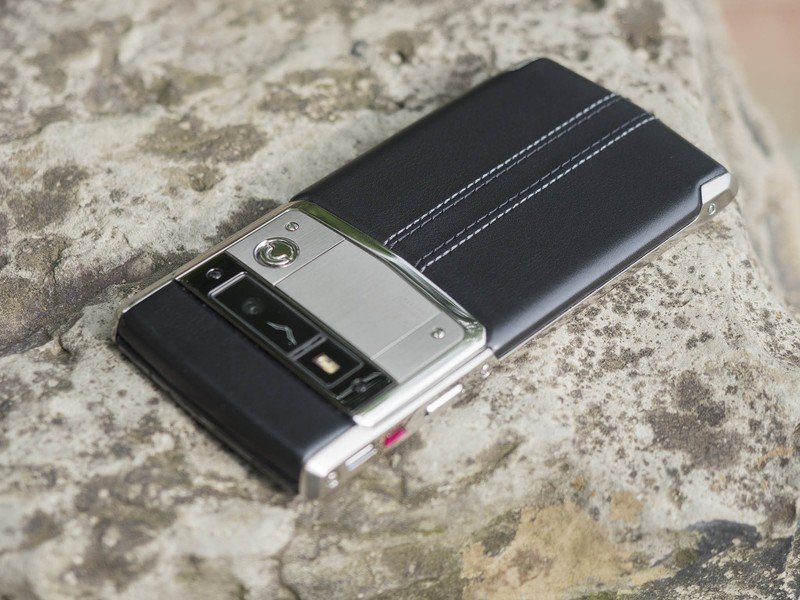
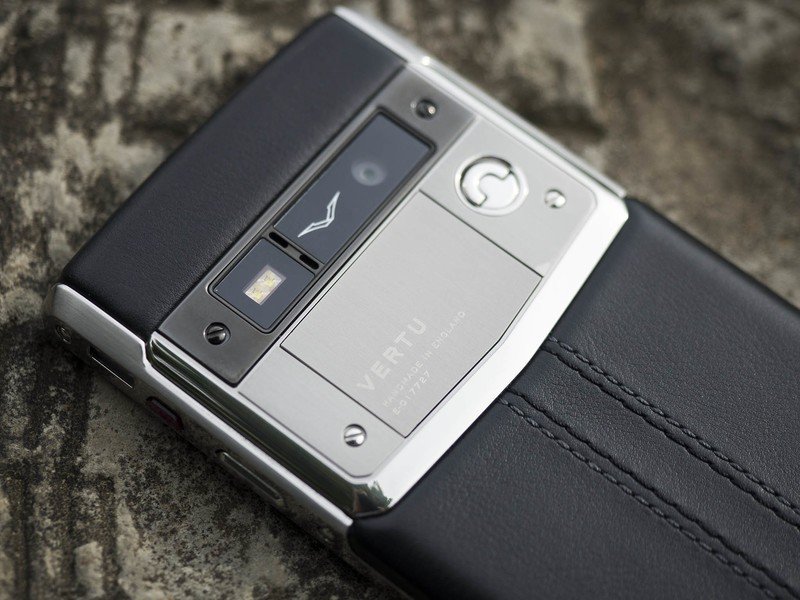
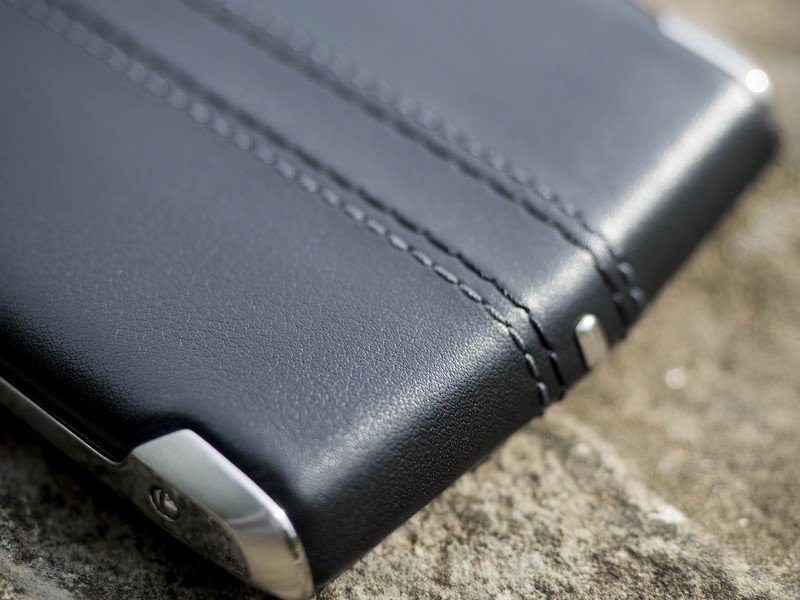
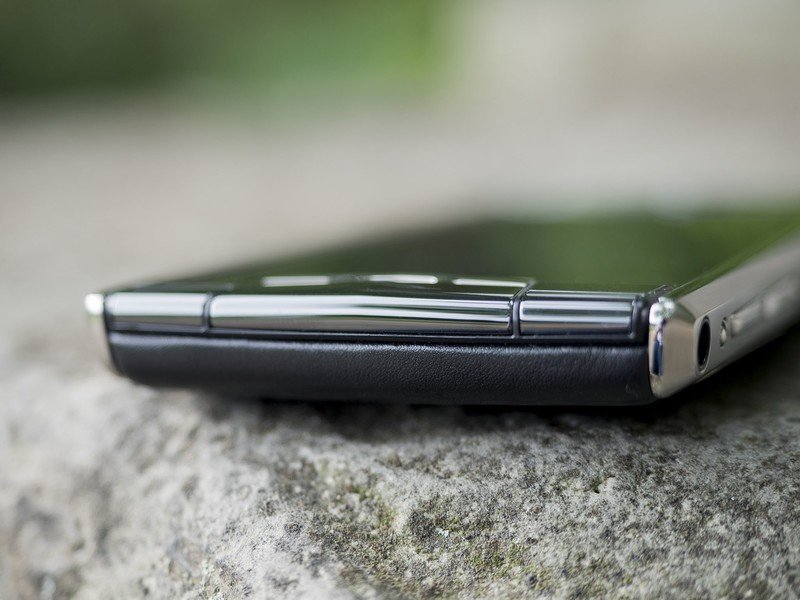
Up on the top half of the back you'll find the camera module and SIM card door. While these would be ho-hum design elements on a normal smartphone, Vertu makes them elements of design flourish. The camera sits on the right with a dual-LED flash on the left, both set behind glass and surrounded by a black metal frame with screws on either side.
Below that is the brushed metal SIM card door, which is etched with the Vertu wordmark, the words "Handmade in England," and the phone's serial number. The door is large, about an inch wide, and is secured by a D-ring latch to the right. Pop up the ring, twist it counter-clockwise, and the latch releases to let the door pop loose. Flipping it open you'll find a Micro SIM slot (Vertu helpfully includes a Nano SIM adapter in the box), and on the inside of the door an attached plate bearing the name and signature of the worker that put the phone together. Mine was assembled by one H. Nguyen, and he or she did a fine job.
Inside the SIM door is the name and signature of the worker that assembled the phone
Compared to every other phone I've owned, the Vertu Signature Touch stands out, at least visually. In a world of black slabs with unibody designs, Vertu's offering up a phone that's visually complicated, and yet really nice looking. It could have easily been overdesigned, and there's an argument to be made that it is when you compare it with something like the iPhone 6 or Samsung Galaxy S6, but there's also an argument to be made for the quality of the design.
All of this makes for a phone that is not small. Despite having a screen the same size as the iPhone 6, the Signature Touch is larger than that phone in all dimensions — and the iPhone 6 was derided for its own tall upper and lower bezels. It's also not a light phone, weighing in at 192 grams (6.77oz), or close to 20 percent more than the Galaxy S6. And yet, despite being bulkier and heavier, the Signature Touch only feels solid in the hand, not heavy. Perhaps it's owing to the unique construction, which gives your hand and fingers more to feel than just a seamless expanse of metal. Regardless, holding the phone just feels nice, and the materials only play a part in that.
An experience in and of itself
Vertu Signature Touch Unboxing
Normally we don't put too much thought into unboxing a smartphone. After all, what are we going to find inside other than the phone, a USB charger, some documentation, and a set of barely adequate headphones (maybe)? Not so with Vertu.
First off, the box is huge. Like, four-times-the-size-of-a-normal-smartphone-box huge. That hugeness is partly because it contains much more, and partly for unboxing experience purposes. Pull off the black cover sleeve and you're still not at the phone — it's inside a large hinged box, lined with suede. The presentation's not unlike a really nice necklace or bracelet, though in this case it's a phone. Below the phone box is a leather sleeve that's stitched to match the back of the phone.
That's just the top third of this box. The bottom half is a drawer that pulls out, presenting first a set of manuals and materials, as well as a certificate of authenticity. Few question if the iPhone you're holding is authentic, but if you're trying to resell a phone that retails for thousands of dollars, you can expect the person to whom you're selling to demand proof that it's the real deal. There are also two microfiber cloths (one small, one huge), and then an array of international power adapters and a 2-amp USB charger.
Also in that drawer is a set of Bang & Olufsen-tuned earbuds. They're styled to match the handset, with shiny metal accents and a flat black cable. Audio response is excellent, and there's an array of inserts to let you adapt the fit to your ears. Vertu sells these earbuds for $230 on their own, and we'd say they're on par with other earbuds in that price range.
It's actually a pretty standard smartphone
Vertu Signature Touch Specs
For a $9,000 phone, you might be expecting something special in the tech department. More than once I was asked if it would wipe my butt or provide other *ahem* services, but as a smartphone the insides of the Vertu Signature Touch aren't exactly special. And that's fine — Qualcomm makes quality processors, after all, and even rich people need something they know is going to work.
The chips inside the Vertu Signature Touch aren't exactly special, nor should they be.
And so inside the Signature Touch you'll find a quad-core Qualcomm Snapdragon 801 processor clocked at 2.3GHz. It's backed up by 2GB of RAM, which as we've seen in flagship plenty of smartphones is enough to reliably drive a 1080p screen and Android 4.4. Storage is set at 64GB, and there's no microSD expansion to be found here.
As mentioned earlier, the screen is a 4.7-inch 1080p LCD. It offers accurate colors, dark blacks, a and a decently-bright backlight. But owing to a combination of factors, including the inherent higher reflectivity of the sapphire cover, it's all but impossible to use in direct sunlight.

Making all of this run is a built-in 2275mAh battery. That's not a substantial cell in by any measure, in fact it's right about the size of the battery in the Moto X (which isn't exactly highly-regarded for its battery life). That might be forgivable if this phone was as thin as the Galaxy S6 or iPhone 6, but at 10.6mm it's more than 50 percent thicker. That there's not a more capacious battery inside the Signature Touch, especially at this size and price, is something of a travesty.
The phone does offer Qi wireless charging through that leather back, though (take that, LG and Motorola), and though you can buy a Vertu-branded Qi charging pad, it'll work with any other Qi charger as you'd expect. Though it's worth looking at their charger: it's an aluminum wedge with a leather pad on which you can rest your phone and get the inductive charge flowing. It's $530, and it'll charge the Signature Touch just as well as a $20 Qi puck will. Though it's certainly more fancy.
| Category | Features |
|---|---|
| Operating System | Android 4.4.2 KitKat |
| Display | 4.7-inch 1080p LCD (473ppi)Sapphire crystal cover |
| Processor | Quad-core 2.3GHz Qualcomm Snapdragon 801 |
| RAM | 2GB |
| Storage | 64GB (non-expandable) |
| Rear Camera | 13MP, Hasselblad certified, dual-LED flash |
| Front Camera | 2.1MP |
| Network | GSM (850/900/1800/1900MHz), WCDMA (Bands I, II, IV, V, VIII), HSPA+ 42Mbps, LTE Cat 4 (Bands 1, 2, 3, 4, 5, 7, 8, 17, 20, 25) |
| Connectivity | Wi-Fi 802.11a/b/g/n/acBluetooth 4.0 LEGPS, NFC |
| Sensors | Accelerometer, compass, gyroscope, proximity |
| Battery | 2275mAh, Qi wireless charging |
| Dimensions | 145 x 69 x 10.65mm (5.71 x 2.72 x 0.42 inches) |
| Weight | 192g (6.77oz) |
| Collections | Polished titanium, jet calf leather, black ceramic pillow: $9,000Polished titanium, claret calf leather, black ceramic pillow: $9,000Polished titanium, seaspray lizard skin, black ceramic pillow: $10,100Polished titanium, damson lizard skin, black ceramic pillow: $10,100Black PVD titanium, jet calf leather, black ceramic pillow: $11,200Polished titanium, jet alligator skin, black ceramic pillow: $12,200Navy PCD titanium, navy lizard skin, black ceramic pillow: $13,000Diamond knurled titanium, newmarket tan diamond quilted calf leather, exclusive Bentley content: $14,200Clous de Paris-engraved titanium, jet alligator skin, black ceramic pillow: $15,600124 white diamonds and white gold pillow, black PVD titanium, jet alligator skin, jet ceramic pillow: $17,900Black PVD titanium, red gold detailing, jet calf leather, black ceramic pillow: $19,000 |
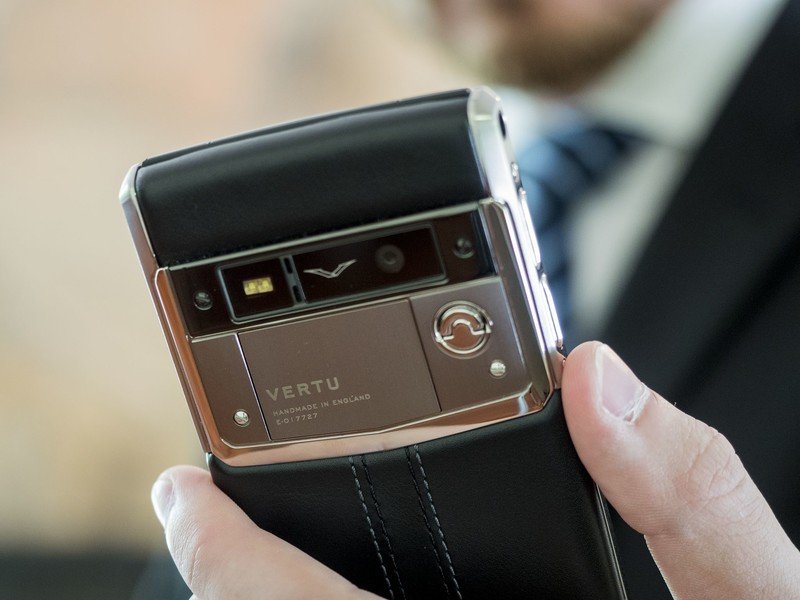
Stock Android, with a nice glass of chianti
Vertu Signature Touch Software and Performance
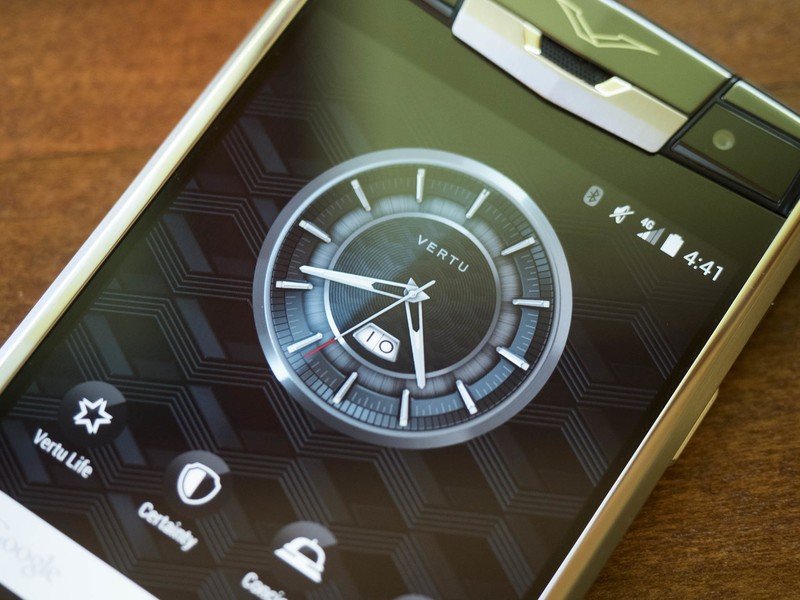
As the above specifications show, once you peel away the titanium and leather and sapphire, you get a device that's pretty much a standard smartphone. To go one step further in the standard, it runs close to stock Android 4.4. Vertu's made a handful of customizations in the form of their own navigation buttons (they're more square than the squat rectangles Google provides) and building in support for Concierge and Dolby tuning of the speakers. There's also a turn-off animation that replaces the winking-out CRT with a Vertu "V" that closes in from the top and bottom and blinks out with a small flash. But all-in-all, it's a pretty light touch to the customizations.
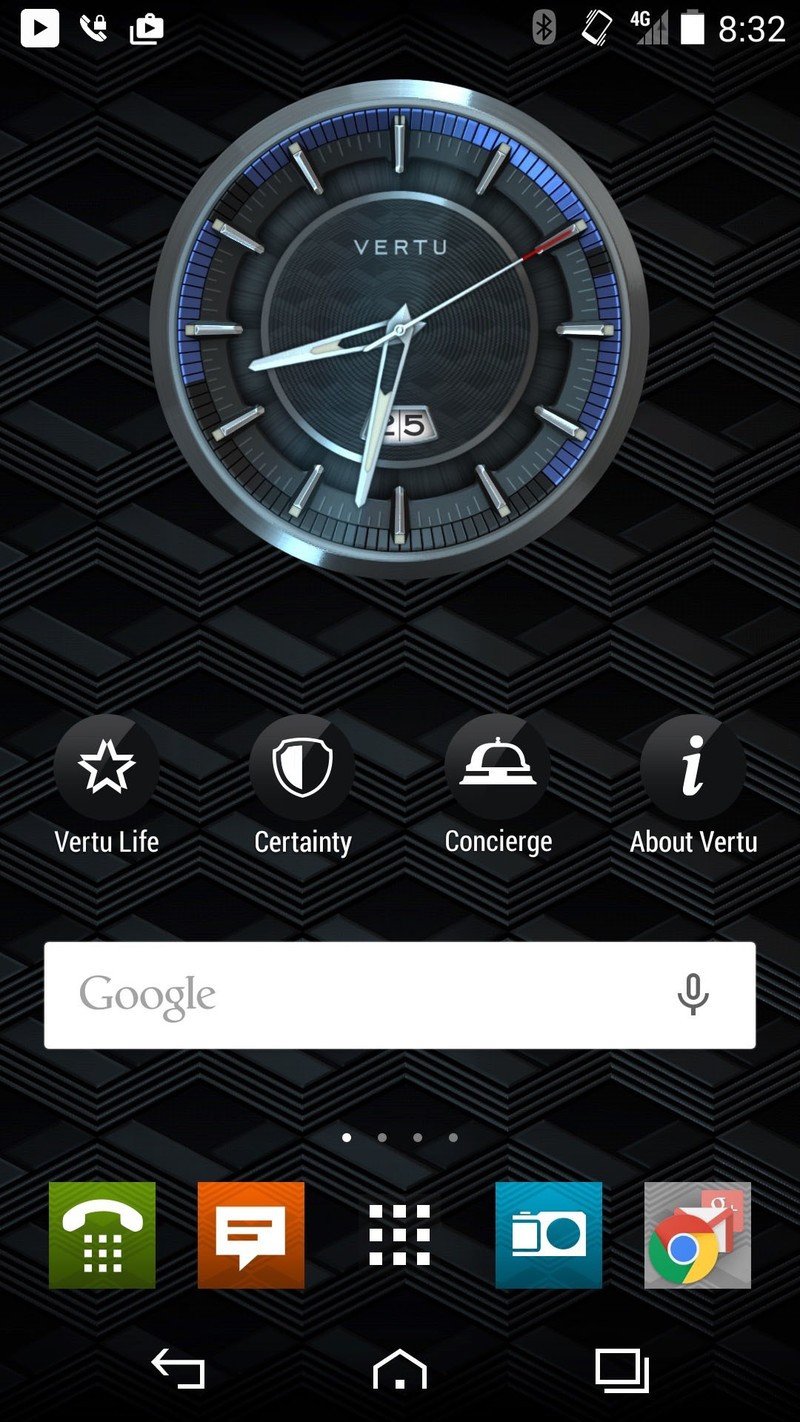
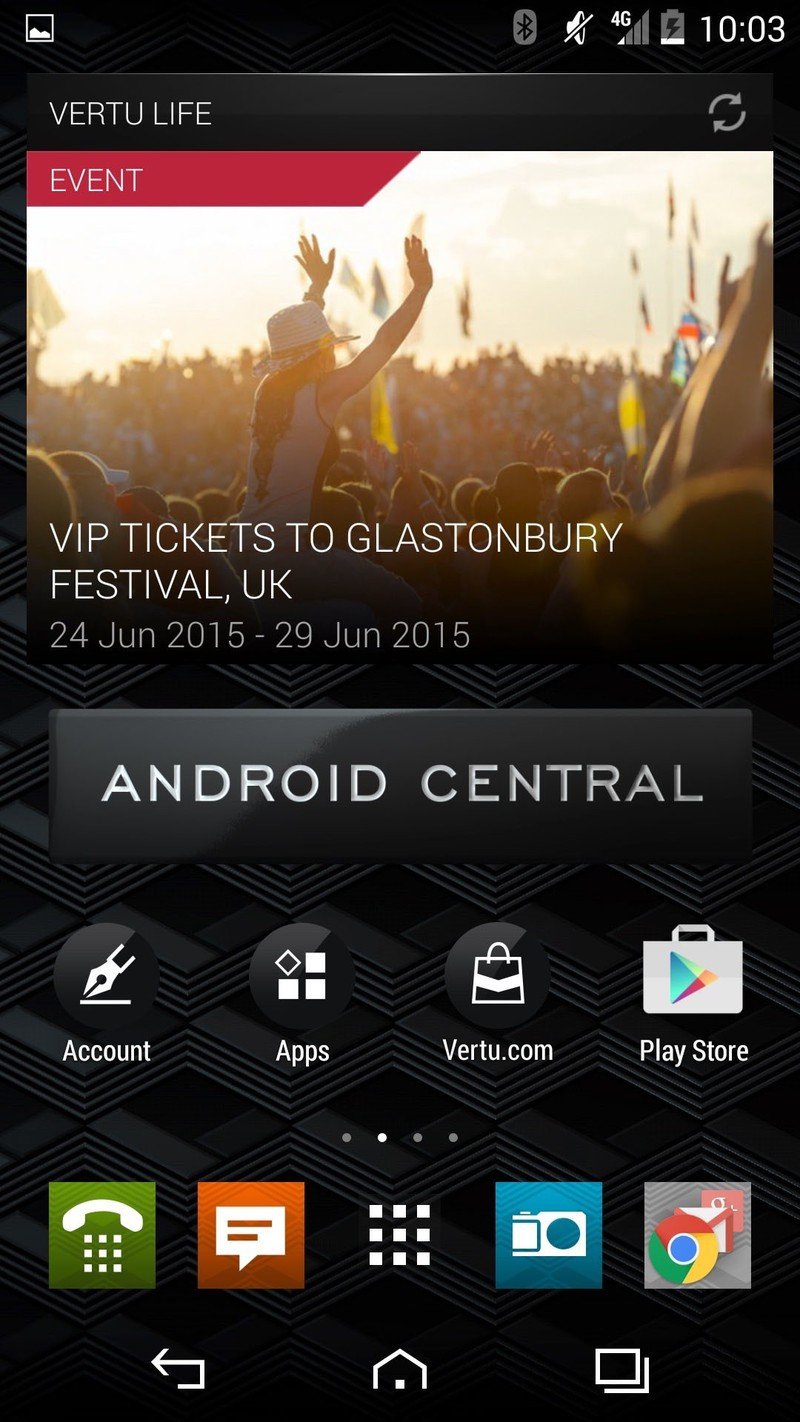
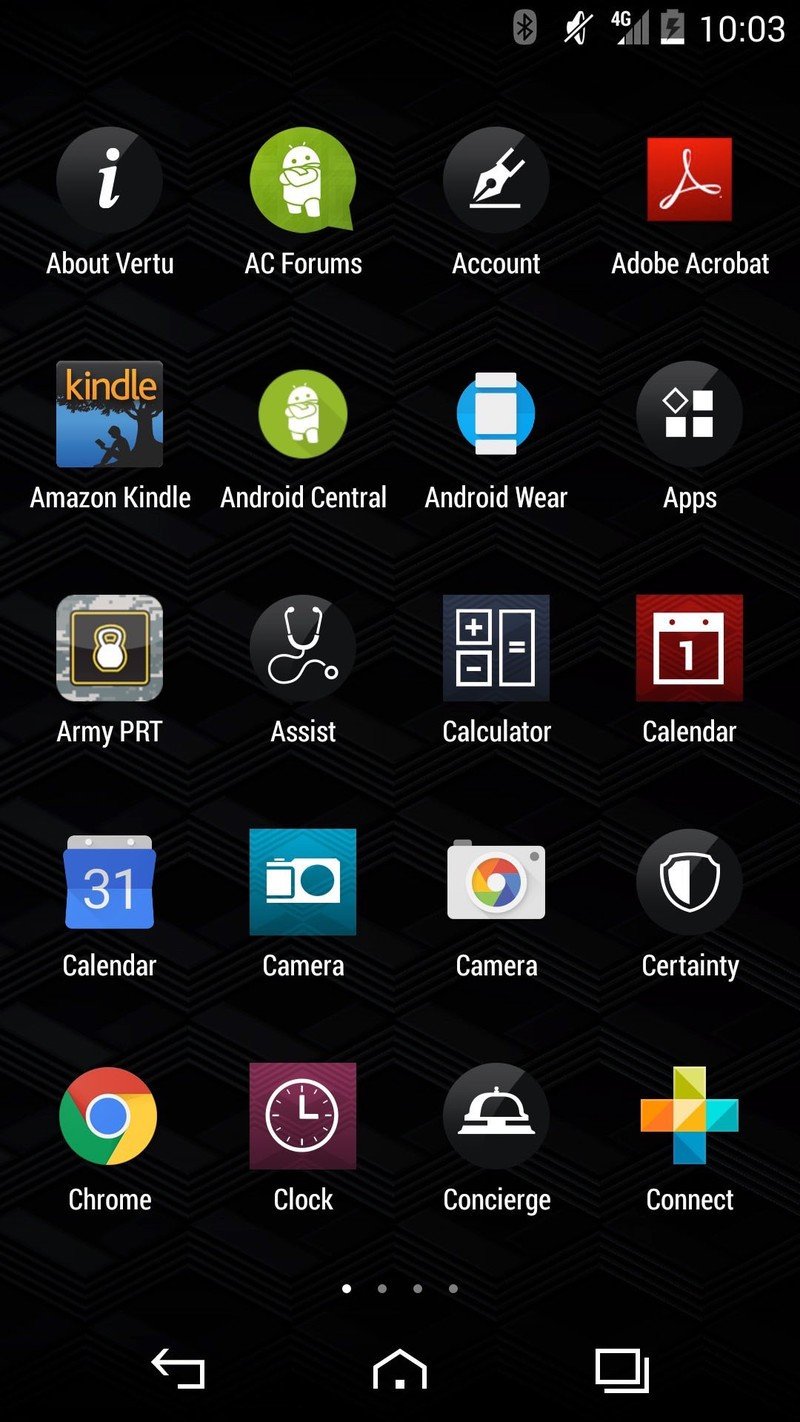
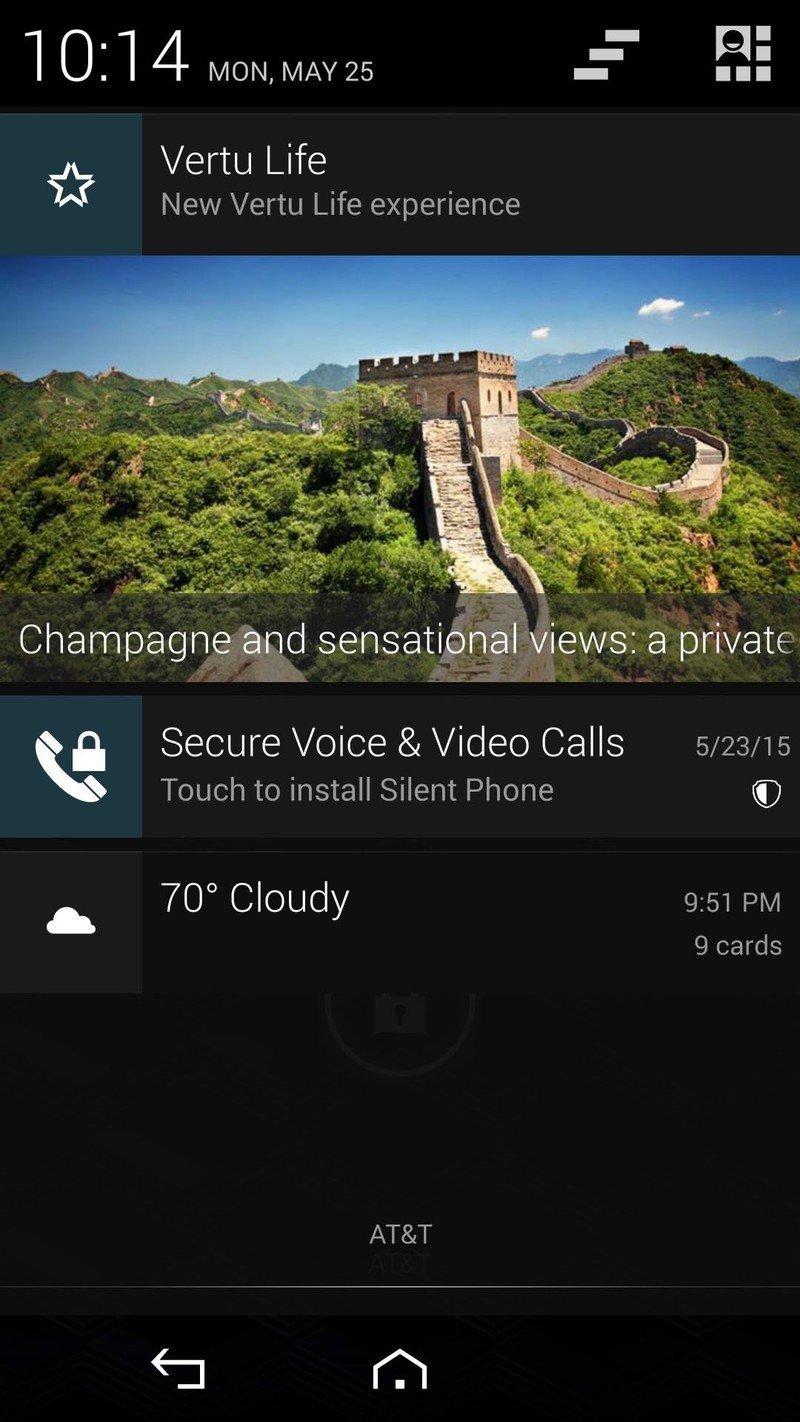
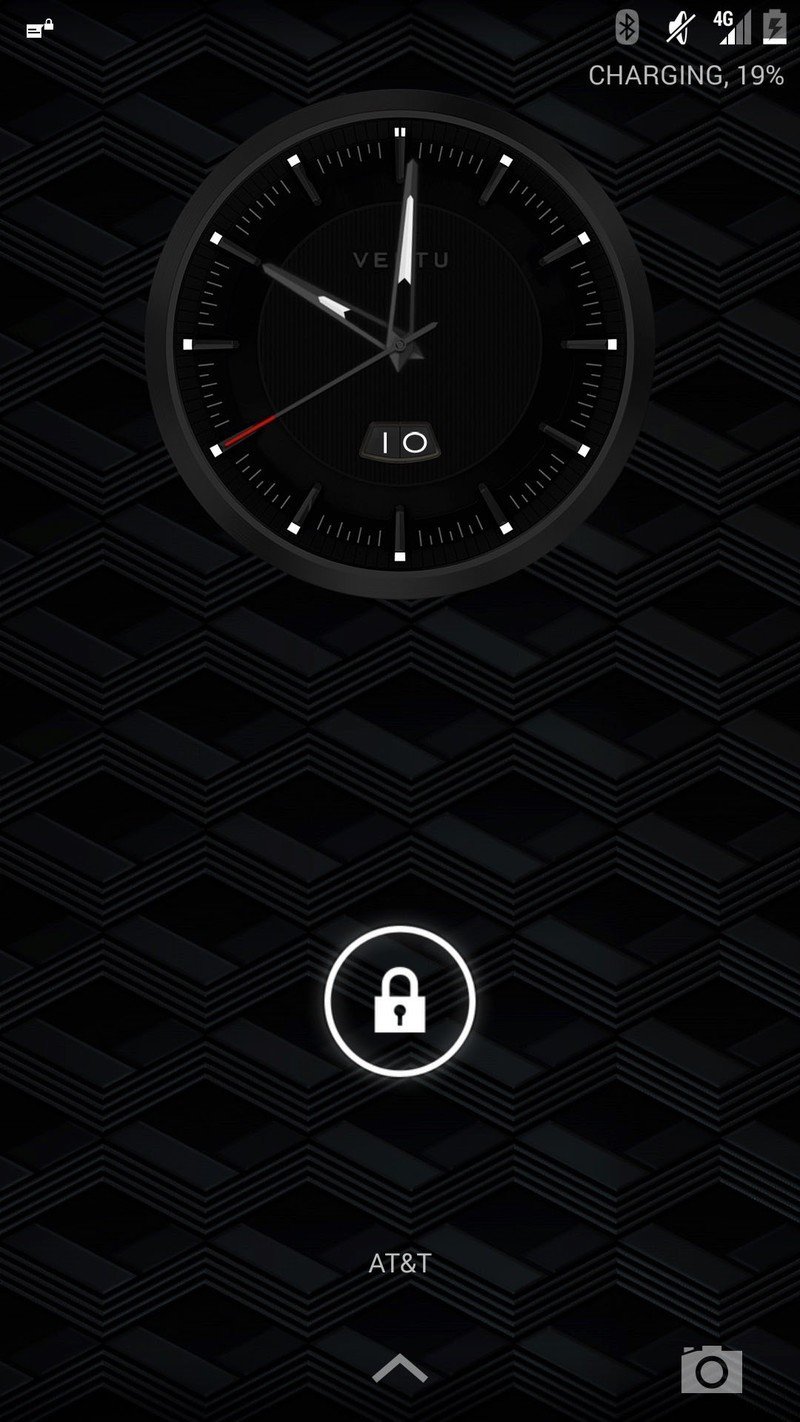
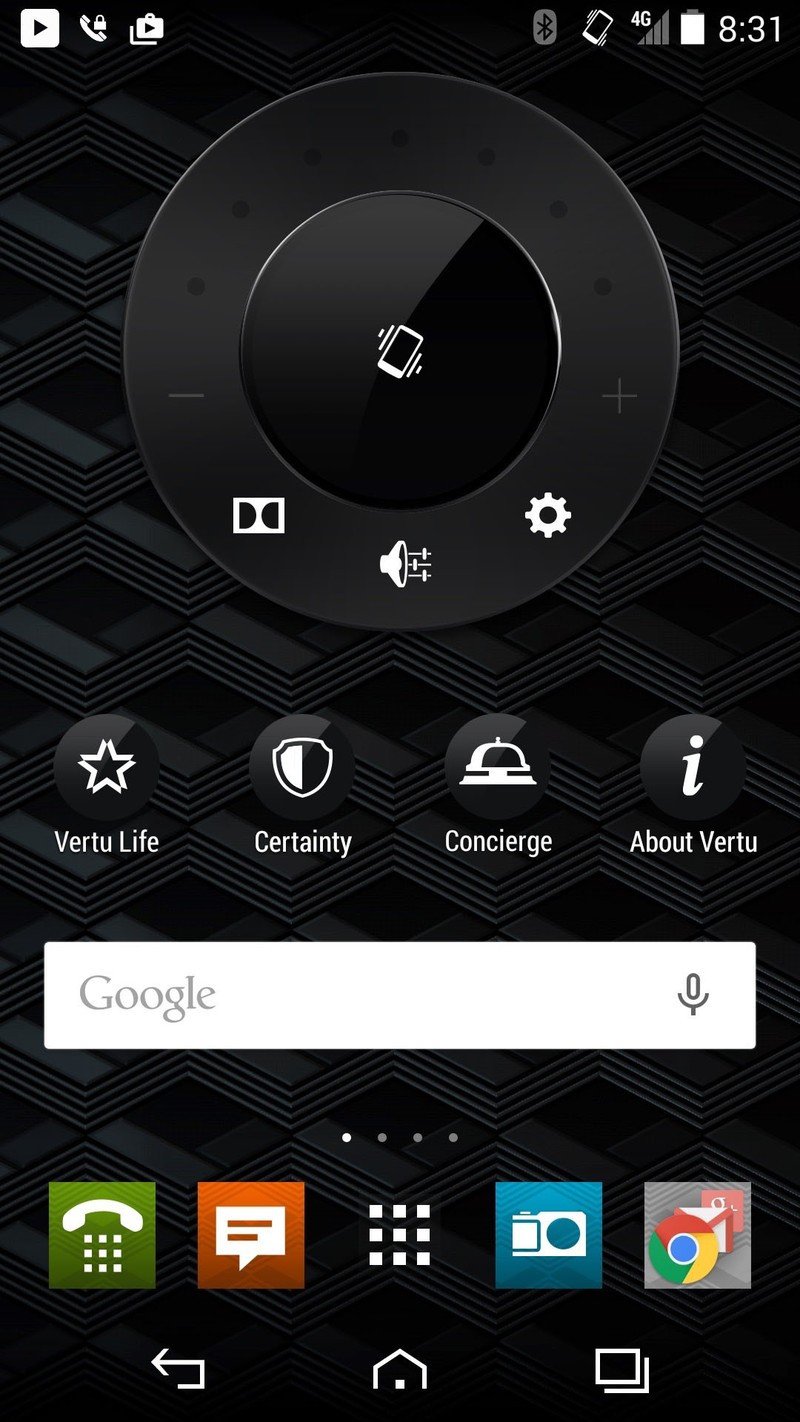
That Vertu took a mostly hands-off approach to customizing Android on the Signature Touch is appreciated, except that it also appears that the mostly hands-off approach went towards performance optimization as well. As we said earlier, this phone is packing a quad-core Snapdragon 801 processor, a chip that's been more than up to the task in its contemporaries. But in the Signature Touch we find ourselves afflicted with annoying lag that comes and goes, at times seizing up the entire phone for seconds.
When you pay $9,000 for a phone, you expect and should get rock solid performance
In the grand scheme, a few seconds here or there shouldn't matter. But when you pay $9,000 or more for a smartphone, you expect rock solid performance. That we didn't get that is an incredible disappointment. Vertu told us that they're working on an update to Lollipop 5.0 (aside: it's weird to be talking dessert codenames like "Lollipop" on a phone this expensive) and but it's not expected for a few more months. Why? Vertu says its customers demand stability above all else and Vertu's relatively small engineering team can't process through optimizing an update as quickly as their competitors might.
Stability was generally there, though on one day we were afflicted with a series of frustrating camera app crashes that were solved only briefly by rebooting the phone. Frustratingly, this was on the day that we'd set aside to test the camera.
The Signature Touch's battery is woefully small for a phone of this size, price, or stature
The biggest issue, however, is the battery. As noted previously, the 2275mAh battery in the Signature Touch is woefully small for a phone of this size, price, or stature. And battery life expectedly suffered. With screen brightness set to auto and a connection to an Android Wear smartwatch running, we consistently found ourselves having to return to the charger before the day was out. On average we got about 12 to 14 hours of normal use out of the Signature Touch. At least it has Qi wireless charging built in, so topping off wasn't a terrible issue.
If Vertu customers demand stability first and foremost, battery life must be the second demand. What good is a stable smartphone for running your vast corporate empire while on the go if the battery's dead before you've sat down for dinner?
Vertu even called after our first few days because they had noticed on their end an authentication issue that was causing the phone to ping their servers every few seconds and was killing my battery life, remotely took control with my permission, and helped to correct the issue. So Vertu gets points for customer service, but they don't quite make up for it with impressive technical chops.
Making luxury phones since 1998
Vertu was created as an arm of Nokia back in 1998, manufacturing candy bar-style handsets running Symbian OS. With Nokia's fortunes turning in 2012, Nokia sold Vertu to a private equity firm for a rumored $200 million. John Stanley, Vertu's head of PR, described the move as the best thing that could have happened to Vertu.
The move away from Nokia allowed Vertu to explore new avenues, which led to their first Android smartphone in the Vertu Ti.
On the subject of customer service, that's what the Signature Touch, and Vertu in general, are about. You see it right from the home screen: there's a nice big analog clock widget that with a ring that lights up when you have appointments scheduled, buttons to launch into Vertu Life, Certainty, Concierge, and then the Google Search bar.
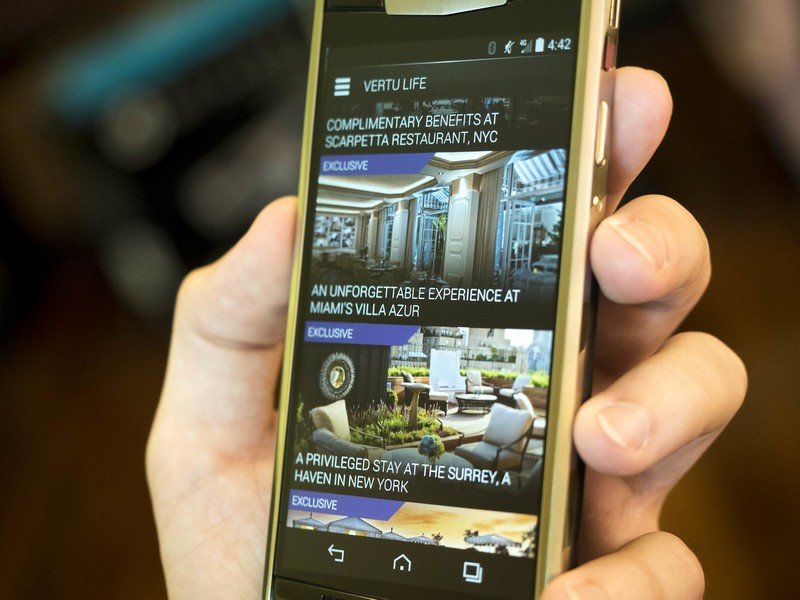
Press the ruby button and the Vertu Concierge app smoothly slides in from the left, offering buttons to access Vertu Life, Vertu Certainty, and Vertu Concierge. Vertu Life is all about providing access to exclusive experiences, be they spas or dinners or concerts. We're talking high-end experiences here, like having a private tour and tea in the penthouse of Diane Von Furstenberg (designer of the DVF wrap dress, apparently) … for just $5,250 per person. Or dine at Marc Forgione's American Cut steakhouse in New York and get priority booking, complimentary dessert and sparkling wine, and a tour of the kitchen. It pays to know people, and Vertu knows people.
Vertu Life also has a widget on the second home screen (right now it's telling us about VIP tickets available for the Glastonbury Festival in the UK), plus notifications when new things are available. Vertu Life has nine broad interest categories with which you can register your tastes: arts and culture, fashion and style, business intelligence, champagne and fine wine, elite world sport, fine dining and gastronomy, VIP entertainment, travel, and technology and gadgets.
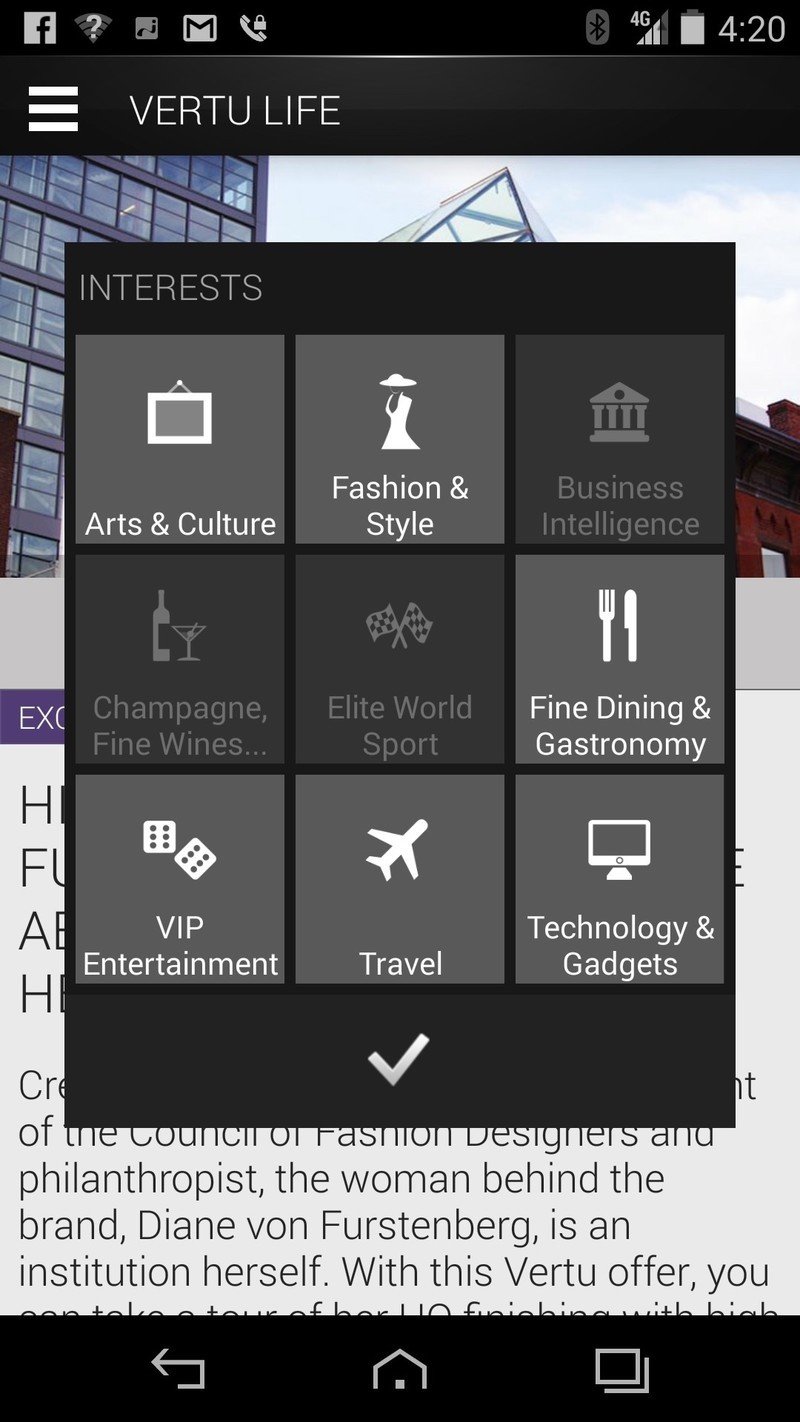
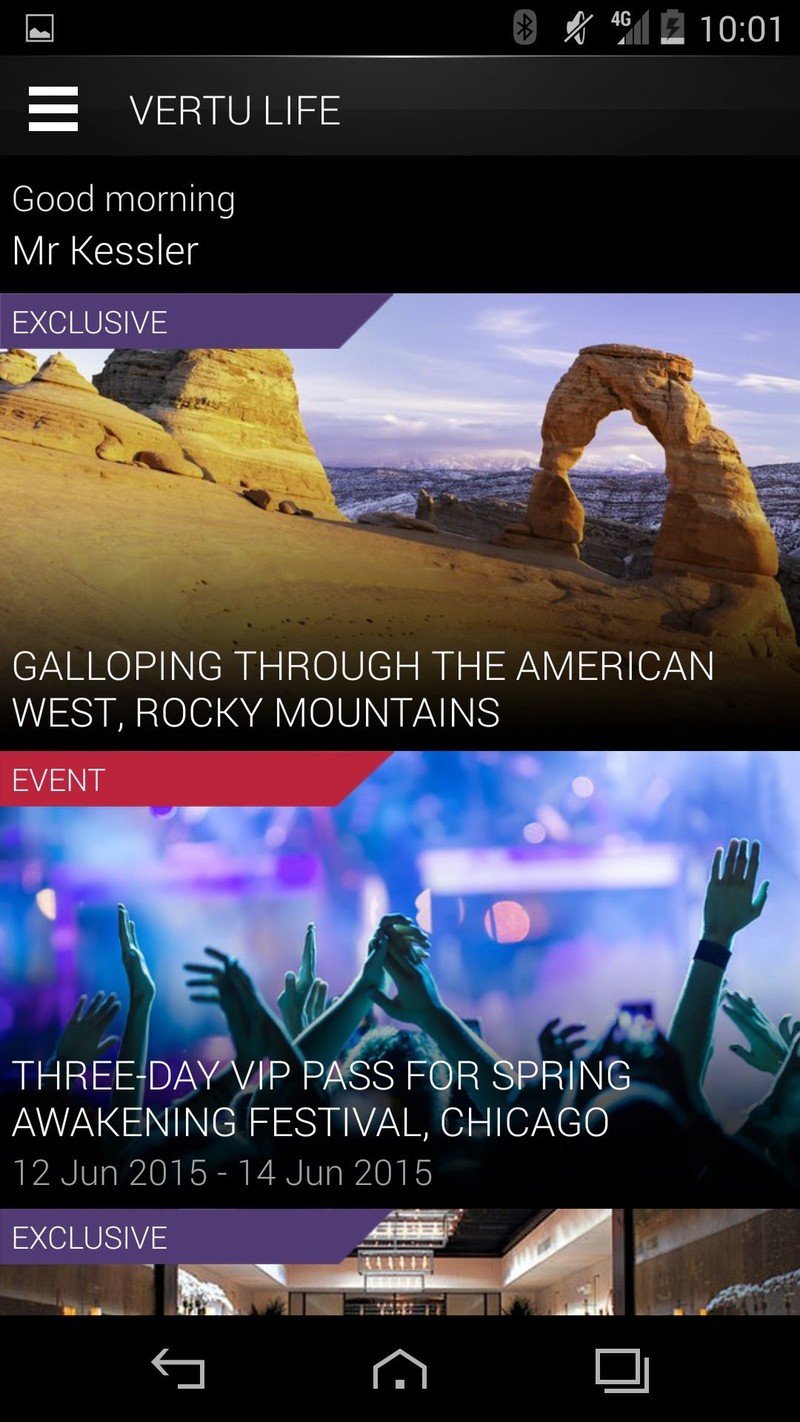
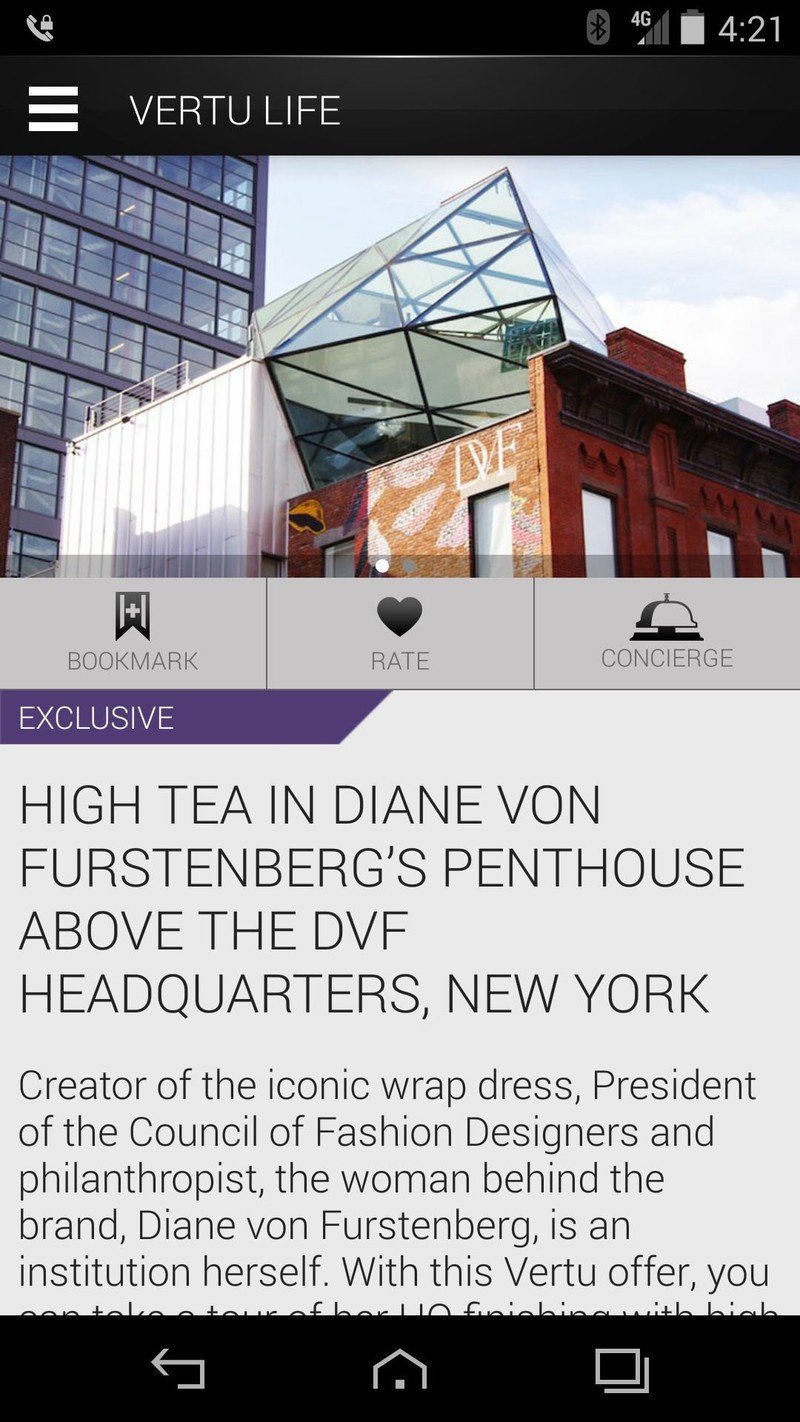
Vertu Certainty is part support and part security. The support aspect comes in the form of 24/7 service support via phone or email, plus remote assistance (used in the aforementioned battery life issue). Under security it simply offers to install a variety of tools, some more useful than others, to ensure the integrity and safety of your data, including Kaspersky Mobile Security, secure calling and messaging from Silent Circle (makers of the Blackphone), and iPass Open Mobile global Wi-Fi. These too will prompt you to install them, though you only have to dismiss each once and be done with it.
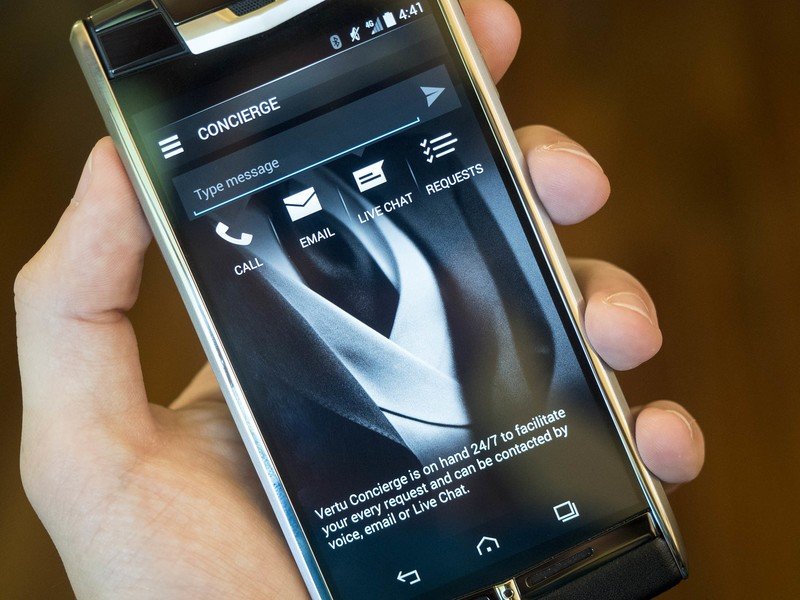
Lastly there is Vertu Concierge, the marquee app and service of Vertu. Concierge starts with a phone call scheduled while you're setting up the phone with a Vertu staffer — mine was scheduled for 4 p.m. the day the phone was received, and Karina from Vertu called at exactly 4 p.m. to introduce herself, explain the service, and get an accounting for the kind of things I regularly do, what sort of entertainment I do, how often I travel, any kids or significant others I need to keep in mind, and other info that would be useful for such a concierge. I must have bored poor Karina with my "anything goes" taste in food and otherwise homebody lifestyle. Maybe a Vertu phone isn't for me.
I used the concierge service a few times in my time with the Signature Touch, though it always felt weird to use it. Perhaps it comes from always doing these sort of things myself, but it was nice to be able to ask for a tailor recommendation to repair a ripped jacket and shortly thereafter get a list of well-reviewed tailors in my area.
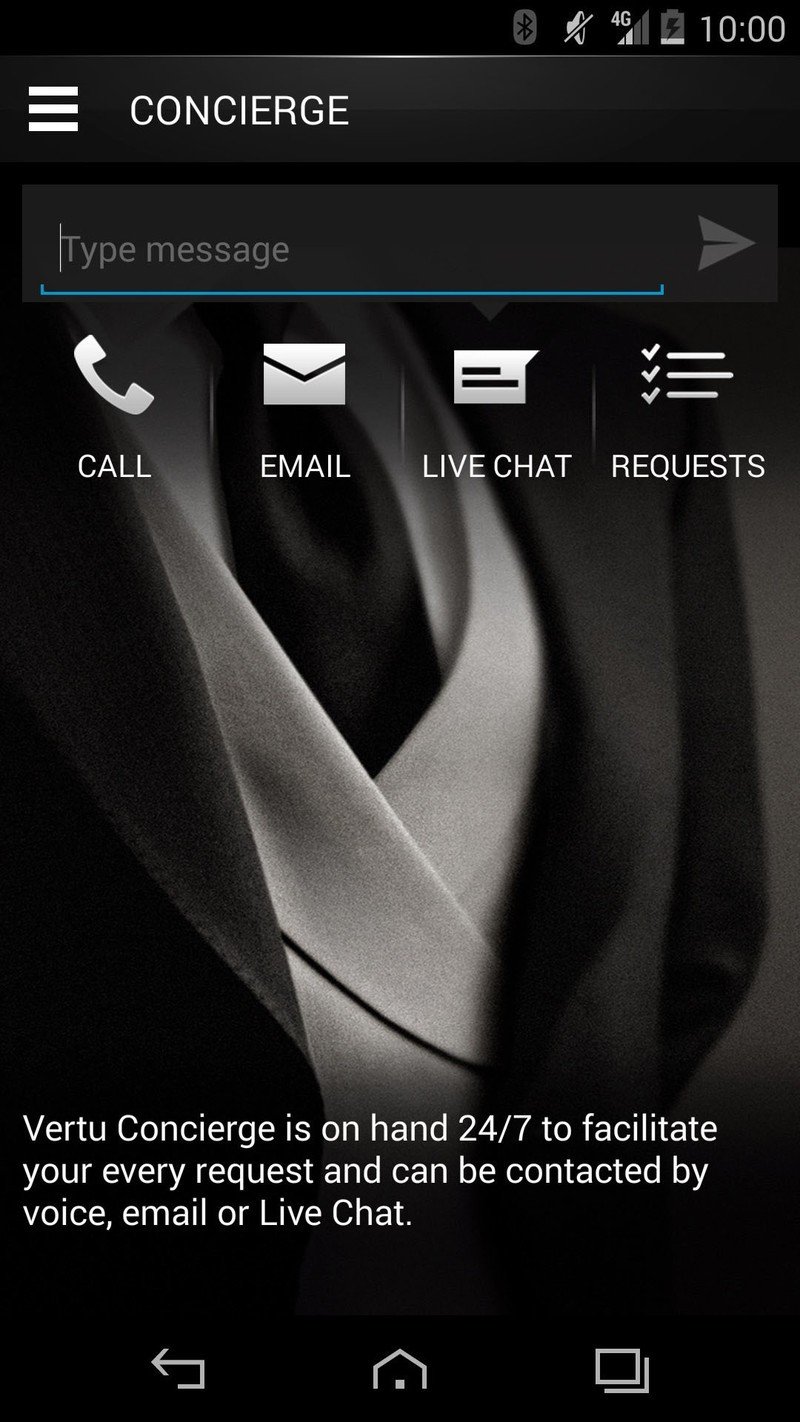
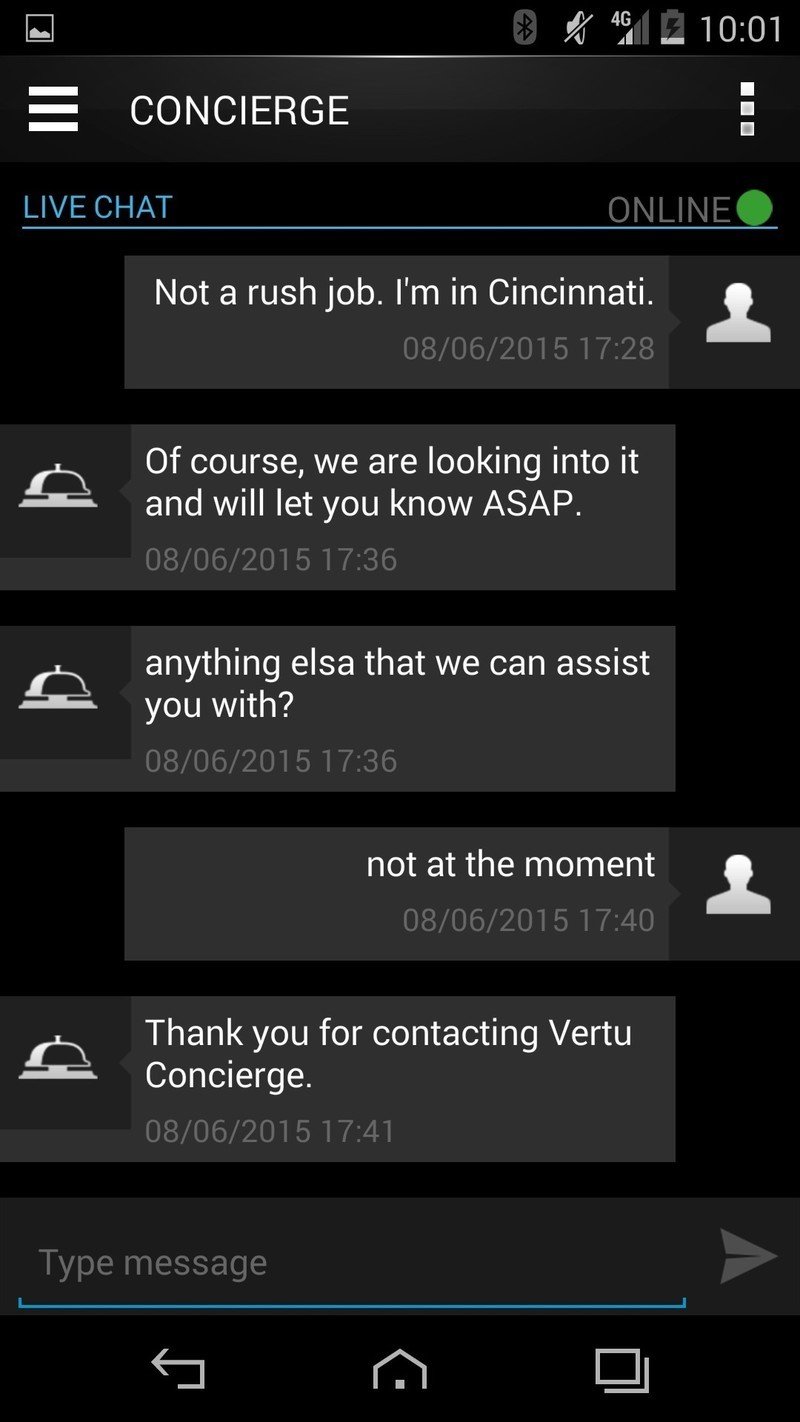
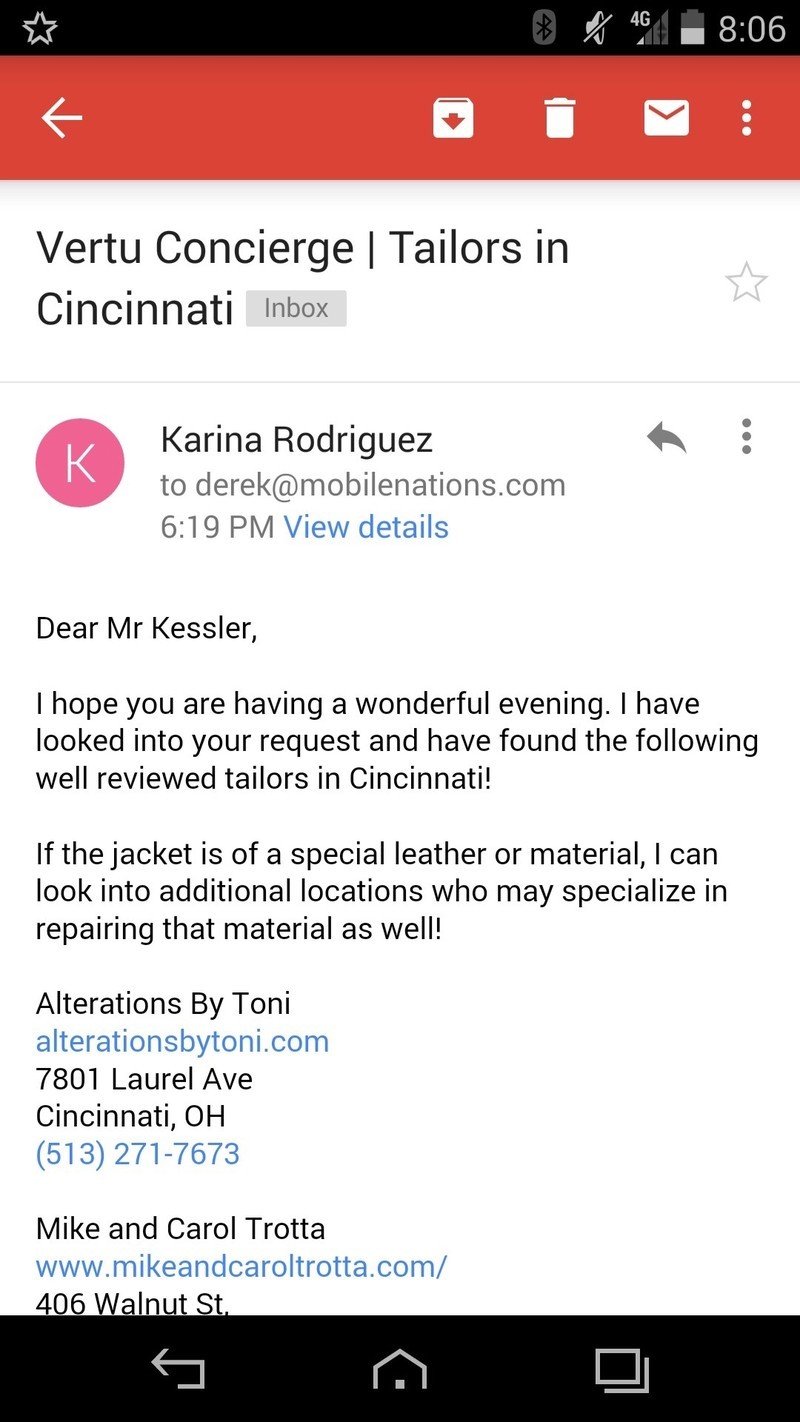
Concierge works in three modes: you can call and have a phone conversation right then and there, you can send an email and get a response back, or you can have a text chat through the app. It's a service that's wasted on somebody like me, I suppose. But I can see it being useful for the busy executive that forgot their anniversary was coming up and needs to book a flight for two to Paris immediately and get exclusive restaurant reservations at places that have months-long waiting lists. Or you can ask for a veterinarian because your dog is behaving more weirdly than normal and the concierge will find the best vets in your area.
Concierge is promised as a 24/7 service with staffers all around the globe ready to take your call at any time. During regular working hours in your area there's an assigned concierge for your account (Karina, in my case), though if I called in at 3 a.m. and she's not there I'd get another equally capable concierge. The global distribution isn't just for time zone coverage — if I'm planning a trip to Istanbul, for example, I could be transferred to a concierge with knowledge of the area to help set things up for me.
Services like Vertu Life and Concierge are what help to justify the price tag of a Vertu phone. The question is if they're worth it to you. Concierge is included with the first year of the phone, and is then $3,000/year afterwards — so you best use it.
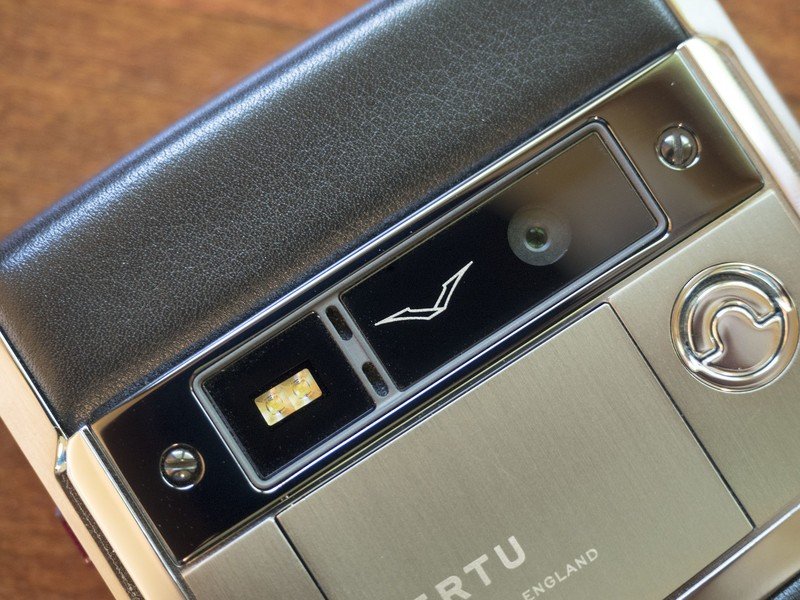
More like Hasselbad
Vertu Signature Touch Cameras
Vertu is quick to tout the Hasselblad-certification of the 13-megapixel rear camera on the Signature Touch, though it's not exactly clear what that entails. Hasselblad is a strong name in quality imaging, offering cameras that run upwards of $40,000 and lenses at $50,000. So their stamp of approval on the Signature Touch's camera should mean something.
But using the camera wasn't all that great of an experience. For starters, it's painfully slow to load, taking up to five seconds on most loads to offer a preview, and then around a second of lag from the time that you tap the shutter button to the moment the photo is captured. And don't turn on HDR if you want quick photos — those took 3 to 5 seconds to process before you could take another photo, even though the three exposures were generally captured in rapid enough procession to not be tripped up by movement. Even the viewfinder preview was afflicted with lag. We installed a few other camera apps just to be sure and they were hit with the same performance issues as well.
















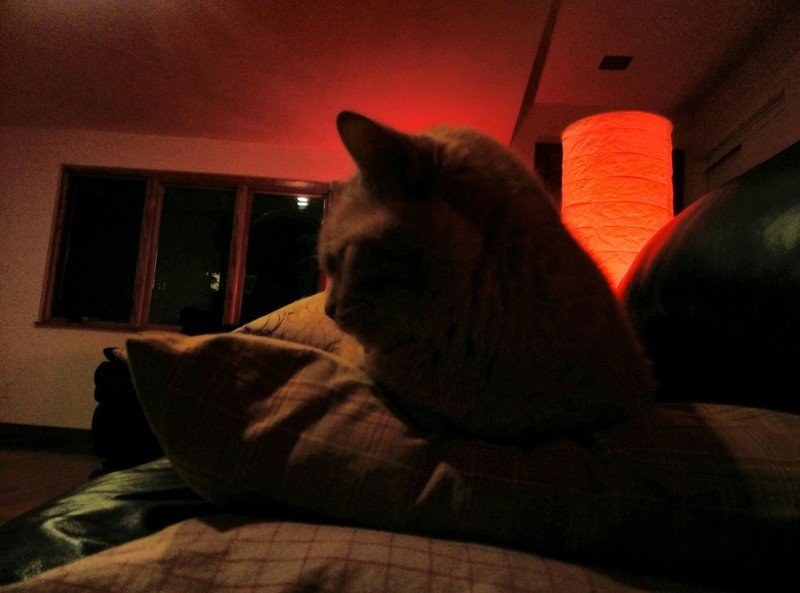


The camera also had a tendency to noticeably oversaturate reds and undersaturate yellows. Thankfully, the camera has little trouble focusing and was able to retain much sharpness when processing images. The front camera, at 2.1 megapixels, was adequate, but nothing to write home about.
Vertu does employ its own custom camera app with a custom interface. It's laid out nicely, with a big shutter button with previous images and mode button at the bottom of the phone and flash, scene, front/rear, and quick settings at the top. Those settings offer a variety of controls, letting you adjust the exposure compensation, white balance, metering zone, and ISO, or you can just do as most people will do and leave those on auto.
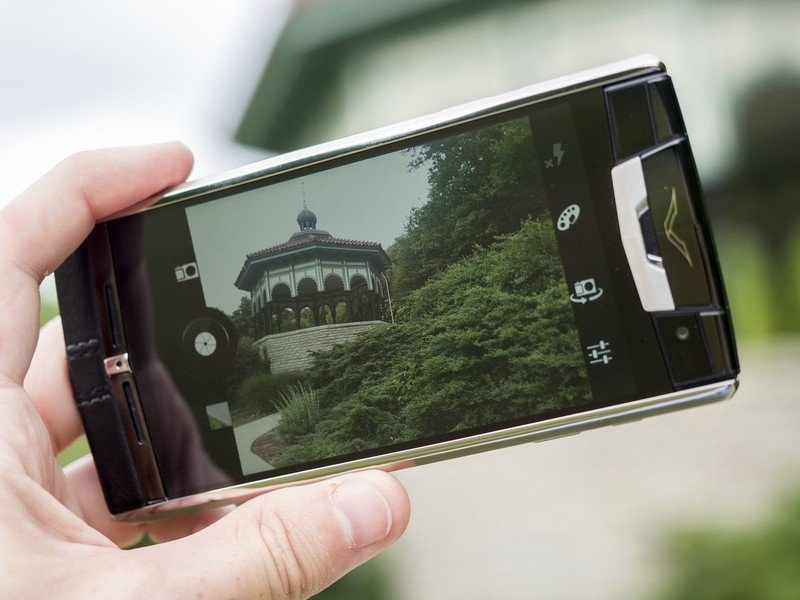
Like the battery, it's practically inexcusable for a smartphone of this size and cost to have this poor of a camera experience. The only saving grace is the stock Gallery app, with its detailed controls for adjusting the image after the fact, but that's not the sort of thing that owners of $500 smartphones should have to worry about, much less owners of $10,000 smartphones.

Feeling like a mogul, even if not living like one
Vertu Signature Touch in real life
So what's it like taking a $9,000 phone and slipping it into your pocket every day? Well, it's just like doing that with a $500 phone. In fact, despite the materials and edges and size, we have no issue carrying around the Signature Touch or putting it into our pockets. Never once did we fear that it would slip out of our hands or that we had to be careful putting it down. The solid build quality and heft was reassuring — we didn't feel any need to put the phone through a durability test (we'd rather not be on the hook for that repair bill), but it felt like the phone could take whatever normal life would throw at it. Or whatever people who can afford these phones consider to be normal life.
That said, the Signature Touch takes its place as the number two most-attention-grabbing phone I've used. First place goes to the iPhone 6 in the first few weeks of availability — plenty of strangers asking if that was the new iPhone — while the Vertu gets the number two slot out of sheer uniqueness. How many people to you know that have one of these? Yeah, that's what I thought. (Vertu's sold fewer than 500,000 phones since their inception, so they're not exactly common.)
Aside from the disappointing battery life and abysmal camera performance, the Signature Touch was a solid performer in daily use. Keeping a cellular or Wi-Fi connection was never an issue, and only when the phone was glitching out and repeatedly pinging at Vertu's servers did it get noticeably warm (despite having a blanket of insulating leather around the back).
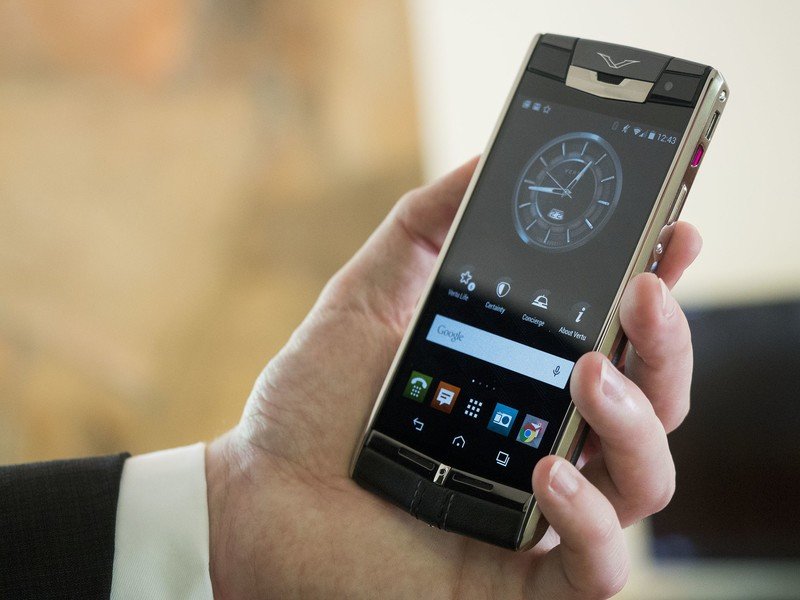

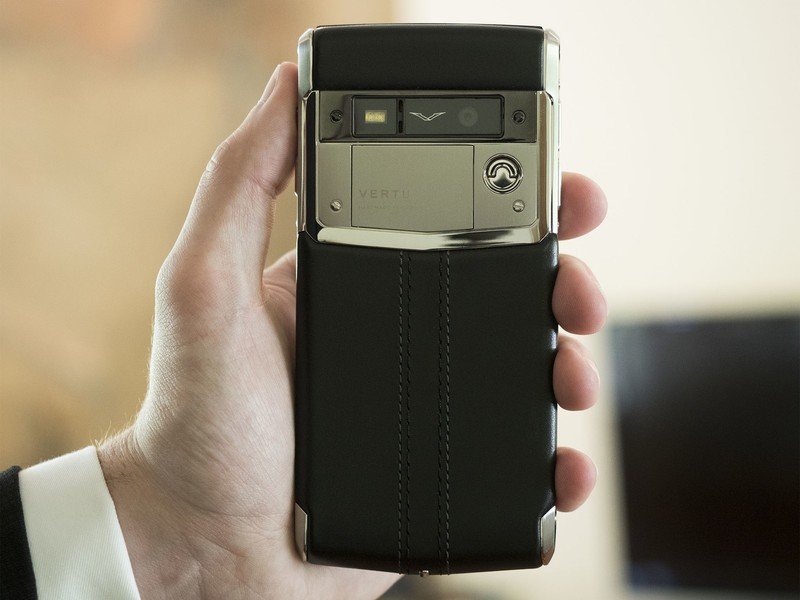
But carrying this phone around made me feel like I had to step up my game. Perhaps it comes just from knowing how much the phone costs (it would be the third-most-expensive thing I'd have bought, after my house and car) and how exclusive it is. I felt weird wearing jeans and a t-shirt while using this phone, though I suppose oil barons wear t-shirts at points too. I felt like I should be jetting off to galas in my private jet and rubbing elbows with my fellow rich and famous. Instead I went to Taco Bell.
I felt like I should be jetting off to galas in my private jet and rubbing elbows with my fellow rich and famous.
At least, that's how I felt initially. After the first several days, that feeling of "this is so fancy" started to wear off. Nothing had changed about the phone, it hadn't been overshadowed by the announcement of a new luxury smartphone, but the novelty had apparently faded. It could still impress people who had never seen one before, but that too was for the sheer novelty.
Concierge was difficult for somebody like me to integrate into my life. I tend not to frequently visit places where I can't get in unless I've booked months in advance and the vast majority of things I need to arrange I can do myself with a simple Google search. But there's something to be said for the convenience of being able to have somebody, at a moment's notice, pick up and help you with something, anything. Take finding a tailor. I could do a search for best tailors in Cincinnati, but very few tailors in the town are rated on Google — I wouldn't know where to start. Maybe I should look at Angie's List or ask for recommendations on a forum? Or I could just ask the Vertu Concierge and get a list of recommended tailors in 30 minutes.
$9,000 gets you a lot of smartphone, and not enough
Vertu Signature Touch: The Bottom Line
The Vertu Signature Touch is an interesting value proposition. On one hand you have incredible materials and build quality making a phone that looks great (or at least unique), feels great, and can take more of a beating than most other phones. On the other hand there's nothing special tech-wise about it — it's a standard Snapdragon 801 phone with a 1080p screen and LTE. But on the other other hand, there's the services side of the Vertu equation, offering unique (if pricey) experiences, proactive support, and a Concierge service that will help you to get what you need any time and any place.
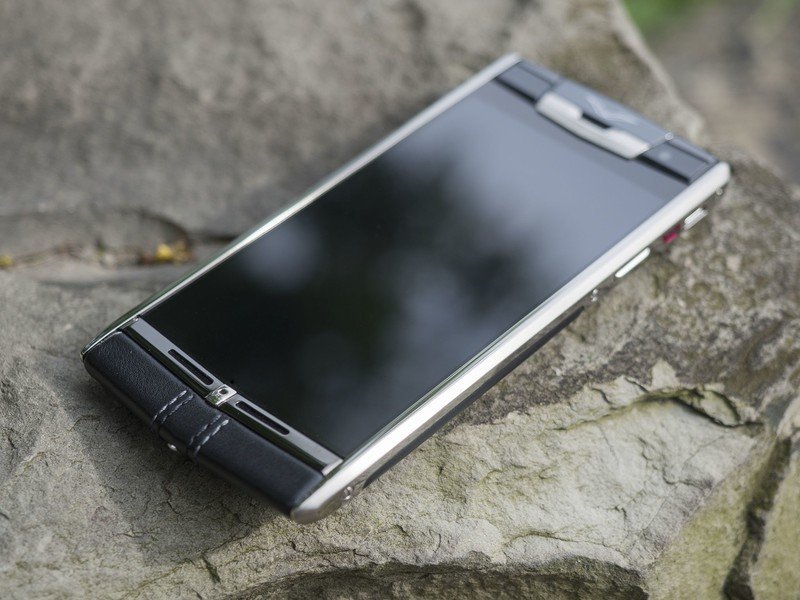
There are things that a smartphone simply will not have a better version of, regardless of how expensive it is. Vertu put the then top-of-the-line mobile processor in the Signature Touch, and at the 4.7-inch screen size there still aren't higher-resolution displays. But as with the gold Apple Watch Edition, it's frustrating that there's not more premium technology at play here. Take battery tech: there's a practical limit when it comes to what Samsung can afford to put in a $700 Galaxy S6, but a company like Vertu selling a phone that runs for thousands of dollars could feasibly afford to buy more advanced batteries or put in 3GB or even 4GB of RAM or include 128GB of storage.
We expect flawless performance from a phone you can buy from the carrier for $200 on a contract, and we should expect the same from a phone that costs 50 times as much. That the Signature Touch is afflicted with glitches and lag at all should be a travesty, not something we should just accept. Granted, the vast majority of us don't have to accept it at all — we're never going to be able consider owning one, let alone have to think about whether it will be up to the task.
And that's worth considering: this isn't a phone made for people like me, and it's probably not meant for people like you either. (Maybe it is, I don't know what your financial situation is.) But the question is if the exclusivity and included services are worth the cost for you over a more standard smartphone.
Regardless, it's still money better spent than on a fancy gold Apple Watch.
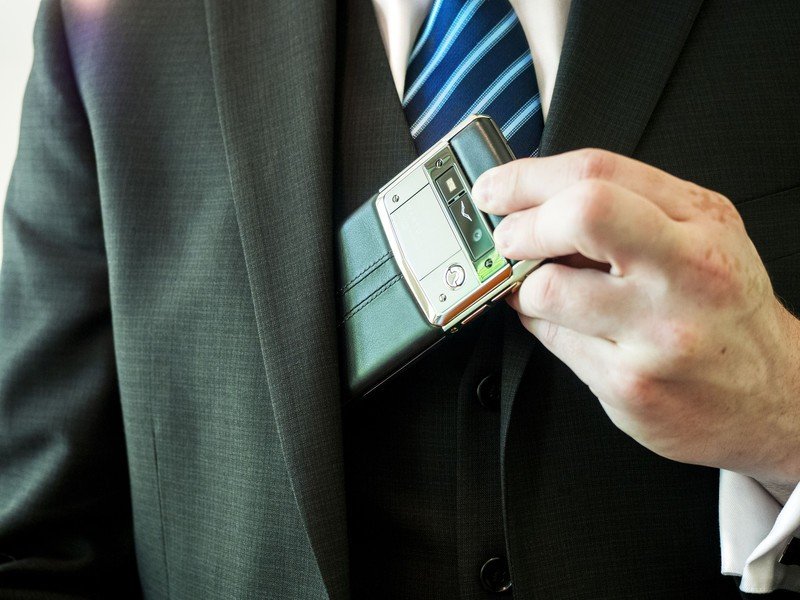
Derek Kessler is Special Projects Manager for Mobile Nations. He's been writing about tech since 2009, has far more phones than is considered humane, still carries a torch for Palm (the old one), and got a Tesla because it was the biggest gadget he could find. You can follow him on Twitter at @derekakessler.
